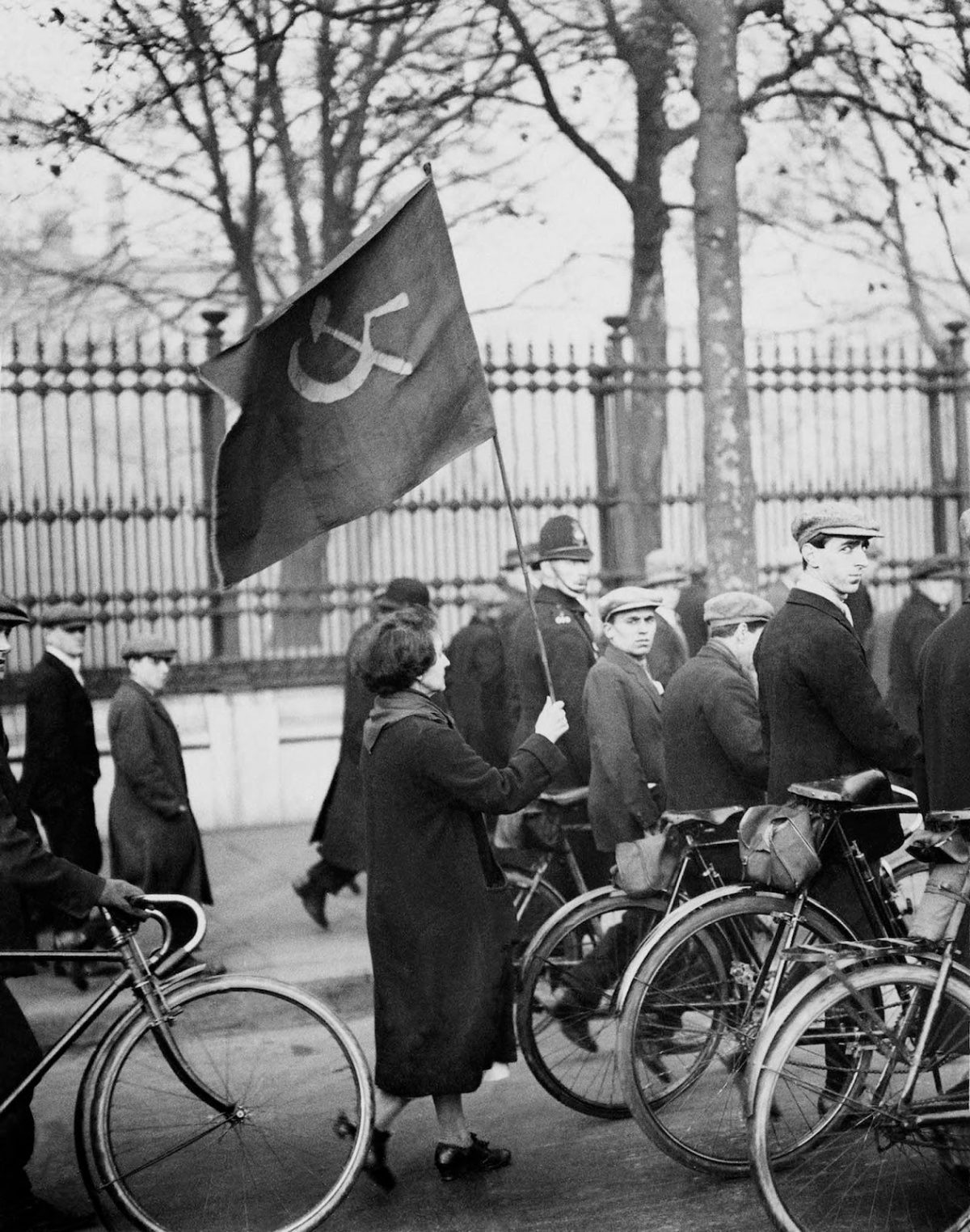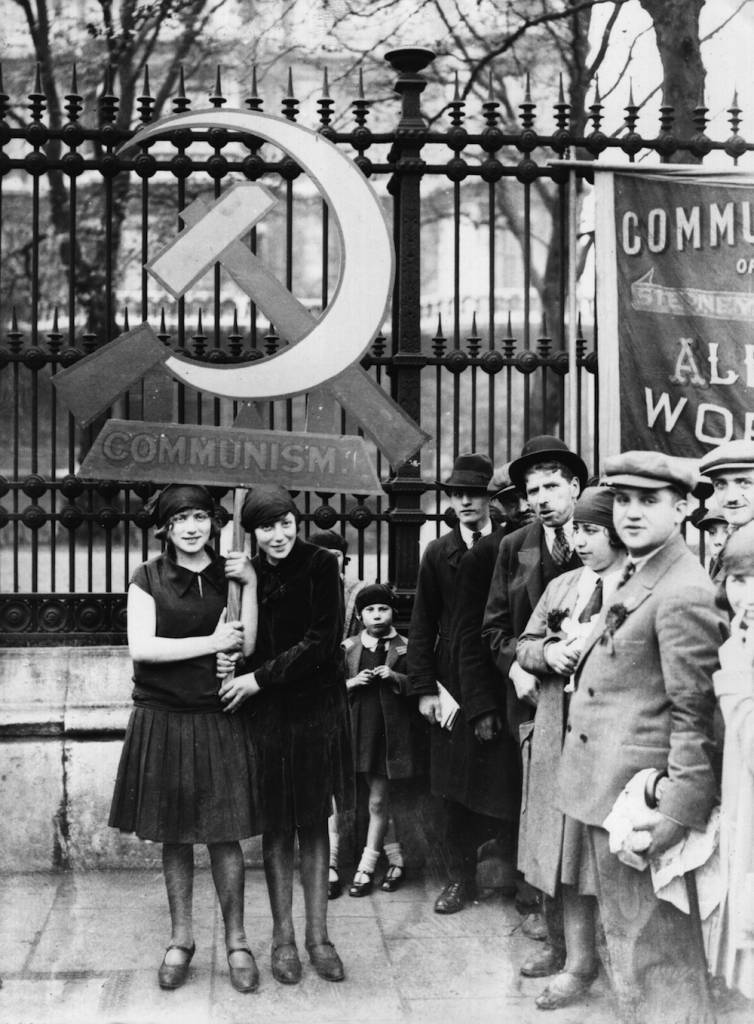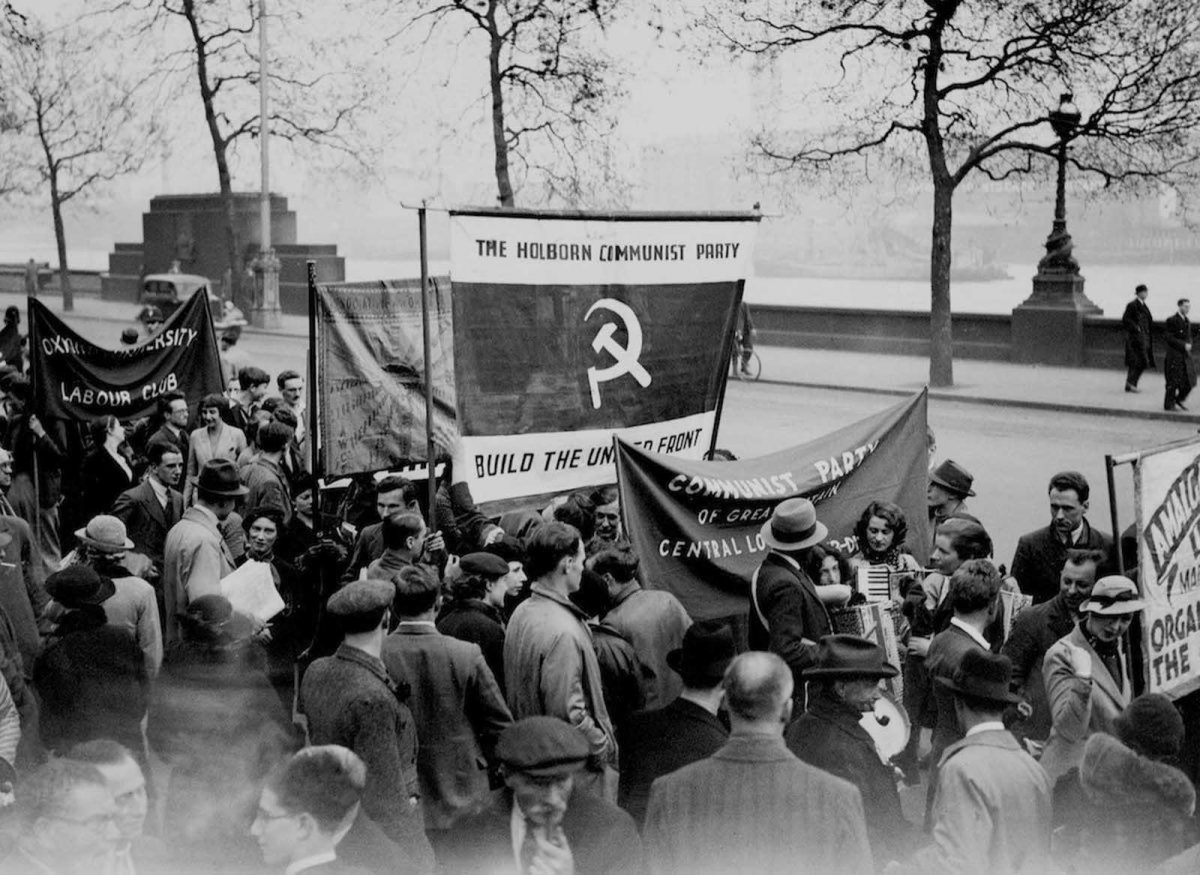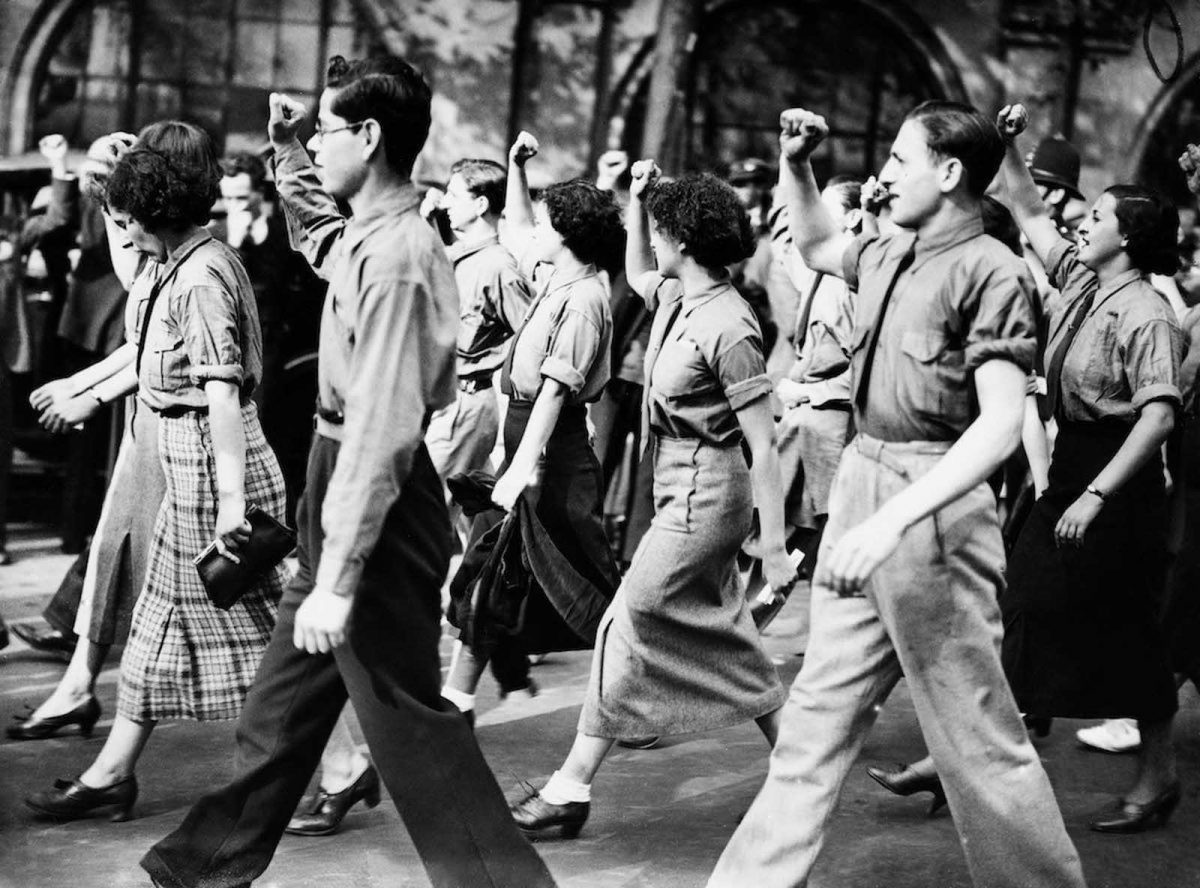When the Iron Curtain fell, in 1991 The Communist Party of Great Britain called it a day and disbanded. It was some fall for the party that in the aftermath of the Second World War counted 56,000 paying members.
Founded in 1920, the CPGB was headquartered at 16 King Street, in London’s, Covernt Garden. The building had, reportedly, been bought by Lenin. Sold in 1976, 16 King Street is now a branch of HSBC bank.
Stuart Hill – one of the “Euro communist” reformers who voted to wind up the party in 1991 – told the BBC:
“The money from the headquarters of the old Communist Party, that was sold to a bullion dealer, ironically. If you wanted to make it up, you couldn’t.”
But the Party was far from a joke. In 1922, Walton Newbold became the Communist Party’s first MP, winning a seat in Motherwell.
Other MPS followed:
1924: Shapurji Saklatvala captured Battersea North.
1935 and 1946: Willie Gallacher took West Fife.
For decades, the most serious threat to Labour’s electoral supremacy here came not from Scottish nationalists, but the communists. West Fife returned Britain’s last Communist party MP, Willie Gallacher, between 1935 and 1950. A housing estate on the outskirts of Cowdenbeath with a street called Gagarin Way is nicknamed “little Moscow”.
1946: Phil Piratin was victorious in London’s Mile End.
At it’s peak the party boasted over 200 councillors.
But the party enver came close to gaining power.
In the 1929 general election, which saw a Labour Government returned, the Party put up 25 candidates who averaged 5.3% of the poll in the areas where they stood. In the 1931 election, after the Labour cabinet spilt and a ‘National’ coalition government took over, the Party’s 26 candidates received 7.5% of the poll.
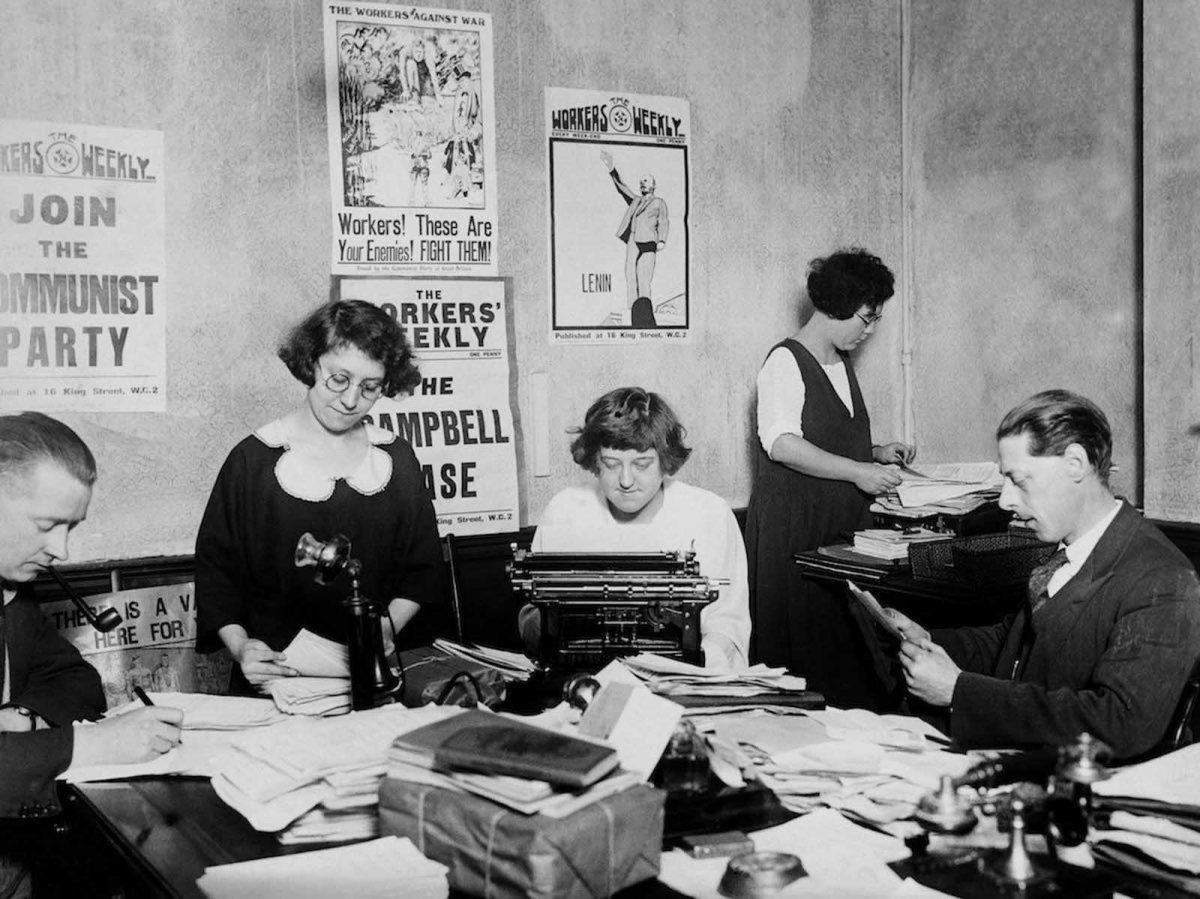
Communist Party electioneering campaign in England. 1928.
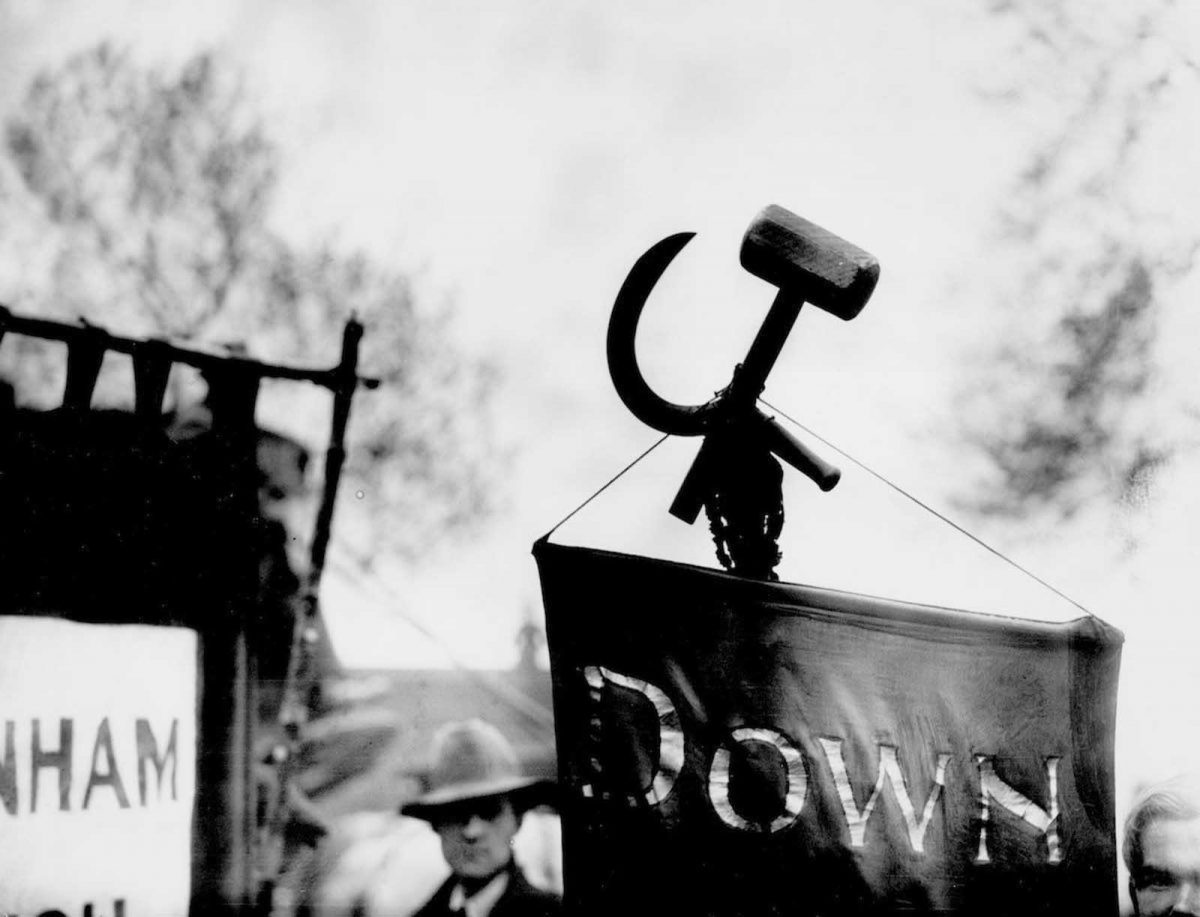
A hammer and sickle attached to a banner at a May Day Labour demonstration. 1928.
Marxist.org:
Membership of the party fell to 2,555 in November 1930 in the wake of deep recession, with over a third of Party members being unemployed. When membership shot up to 6,000 in 1931, the bulk of the recruits were unemployed, as the Party spearheaded the fight back against mass unemployment, which reached 20% of insured workers throughout most of 1932. Now becoming perceived by many as the only serious opposition to fascism, the Party’s fortunes rose with the approach of war and reached a peak of about 16,000 at the outbreak of the Second World War, rising to about 56,000 by the end of the War. As well as winning two MPs and over 100,000 votes in the 1945 General Election, its 21 candidates garnered an average vote of 14.6%. The Party also took over half a million votes in the following year’s local council elections, as the number of Communist councillors increased from 81 to 215.
The onset of the cold war and bans on Communists holding office in unions saw membership and support slumped. After the 1956 revelations on the nature of Stalin’s rule by Krushchev, and the massive internal controversy over what position to adopt over that year’s Hungarian Uprising, the Party was deeply damaged by the loss of a third of its membership overnight, including many senior trade union leaders. The Party also lost the widespread support of the intelligentsia that it has won in the 1930s. The subsequent Soviet military intervention in Czechoslovakia in 1968, saw a deep fissure develop inside the Party that lay the basis for trouble ahead.
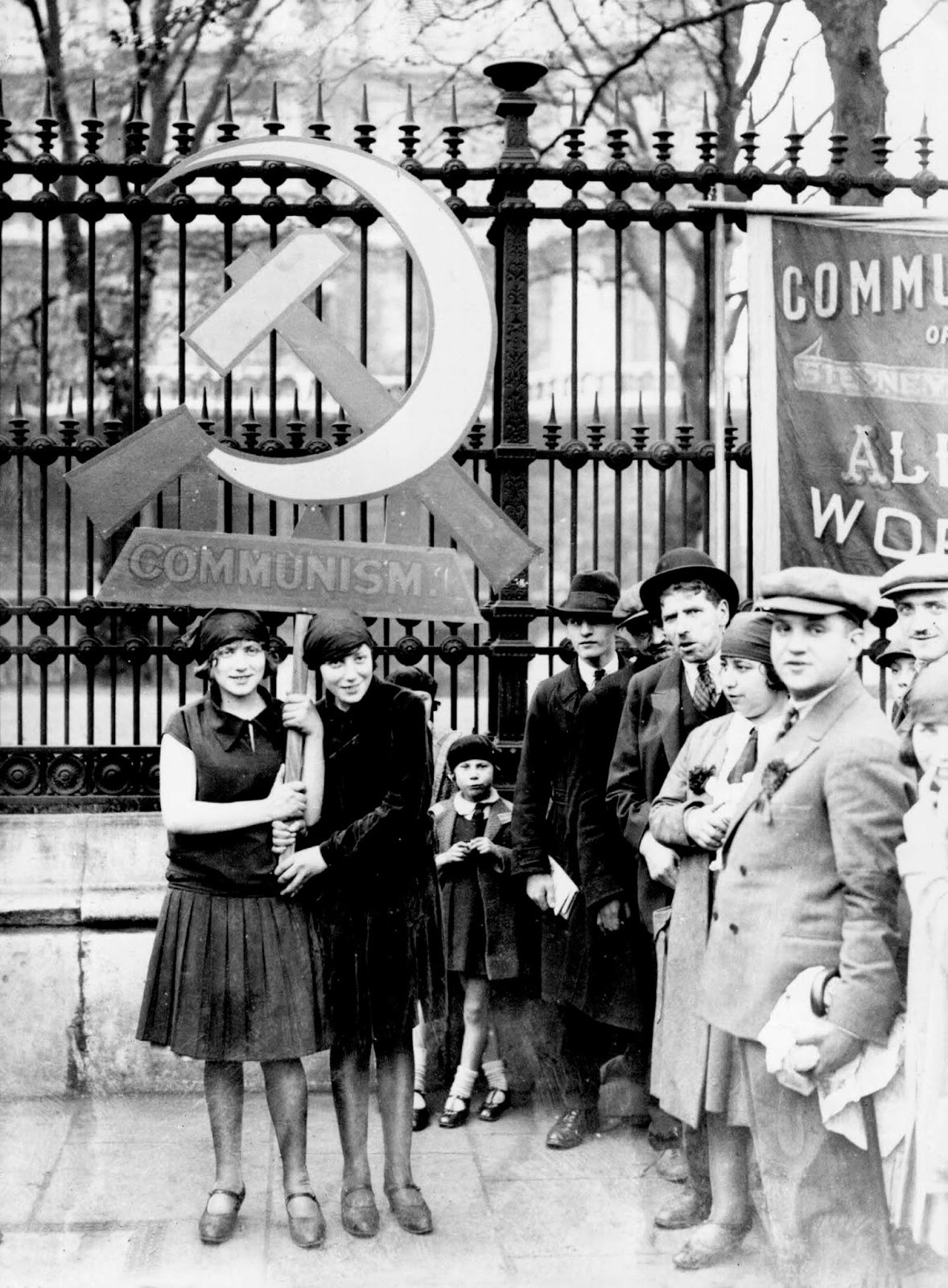
Communists in London celebrating May Day. 1928.
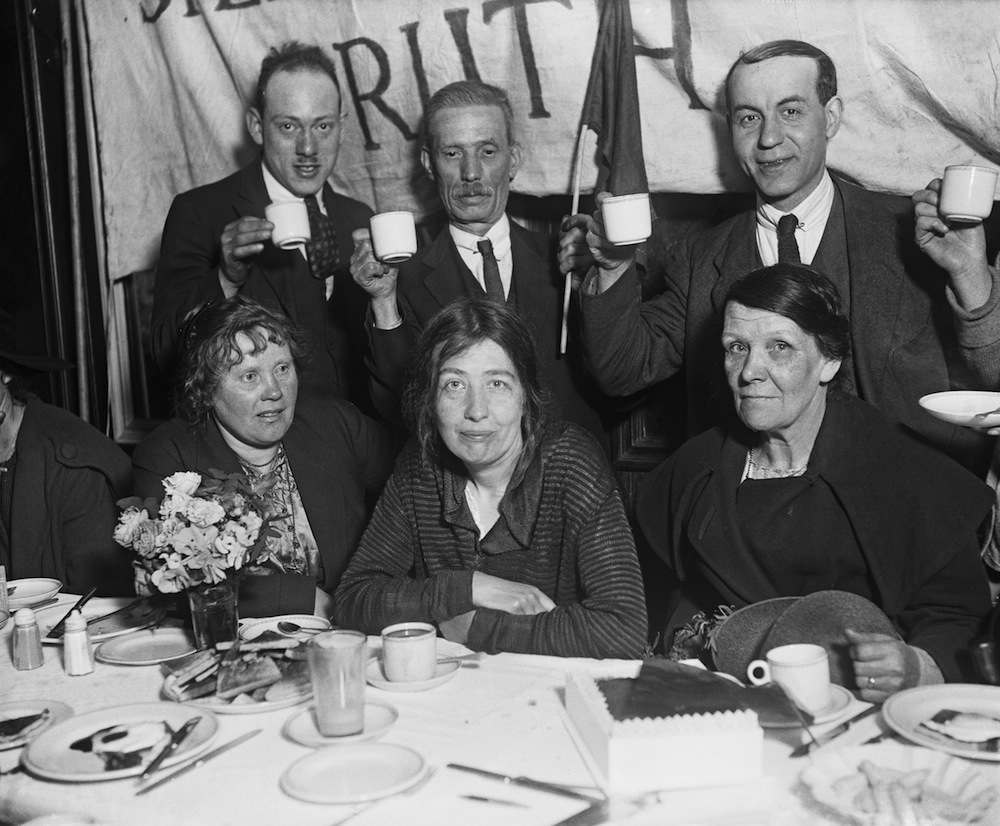
May 01, 1921: Supporters toast suffragette campaigner Sylvia Pankhurst (1882 – 1960, centre) at a breakfast to celebrate her release from prison, east London, May 1921. Pankhurst had been imprisoned since October 1920 for allegedly seditious articles in her Communist Party newspaper The Workers’ Dreadnought. (Photo by Topical Press Agency/Hulton Archive/Getty Images)
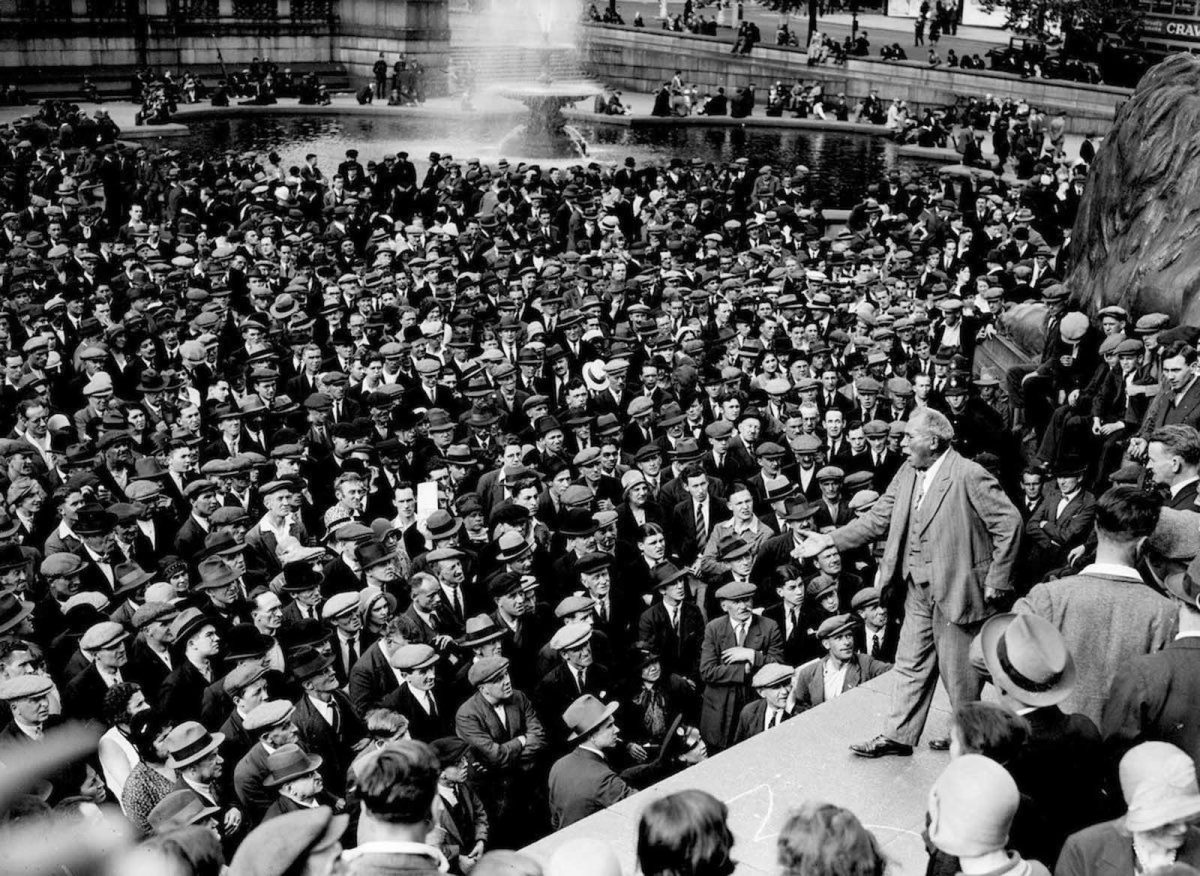
Veteran Trade Unionist Tom Mann (1856-1941) addressing a Communist meeting in Trafalgar Square, London. 1931.
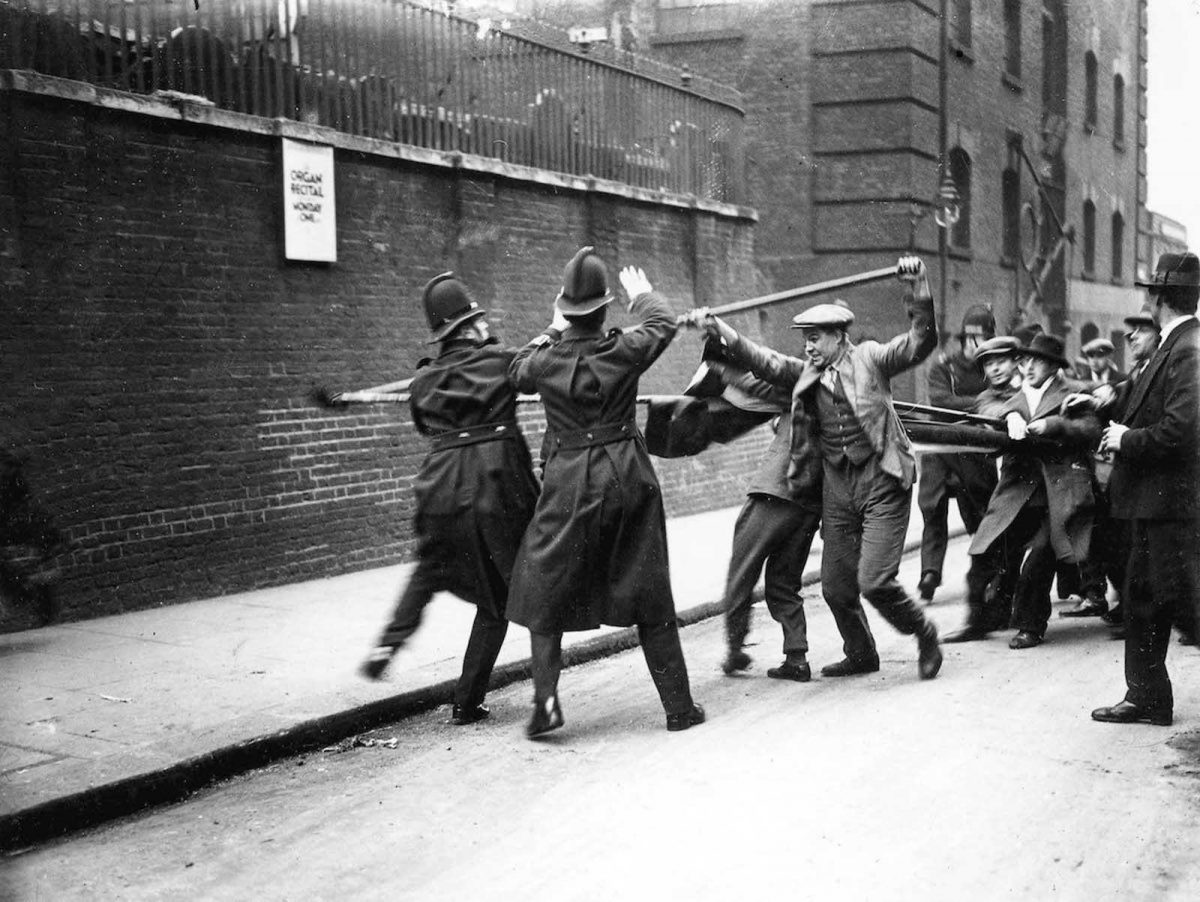
Tower Hill, London – Communists armed with batons, fight police during a demonstration against unemployment. 1930
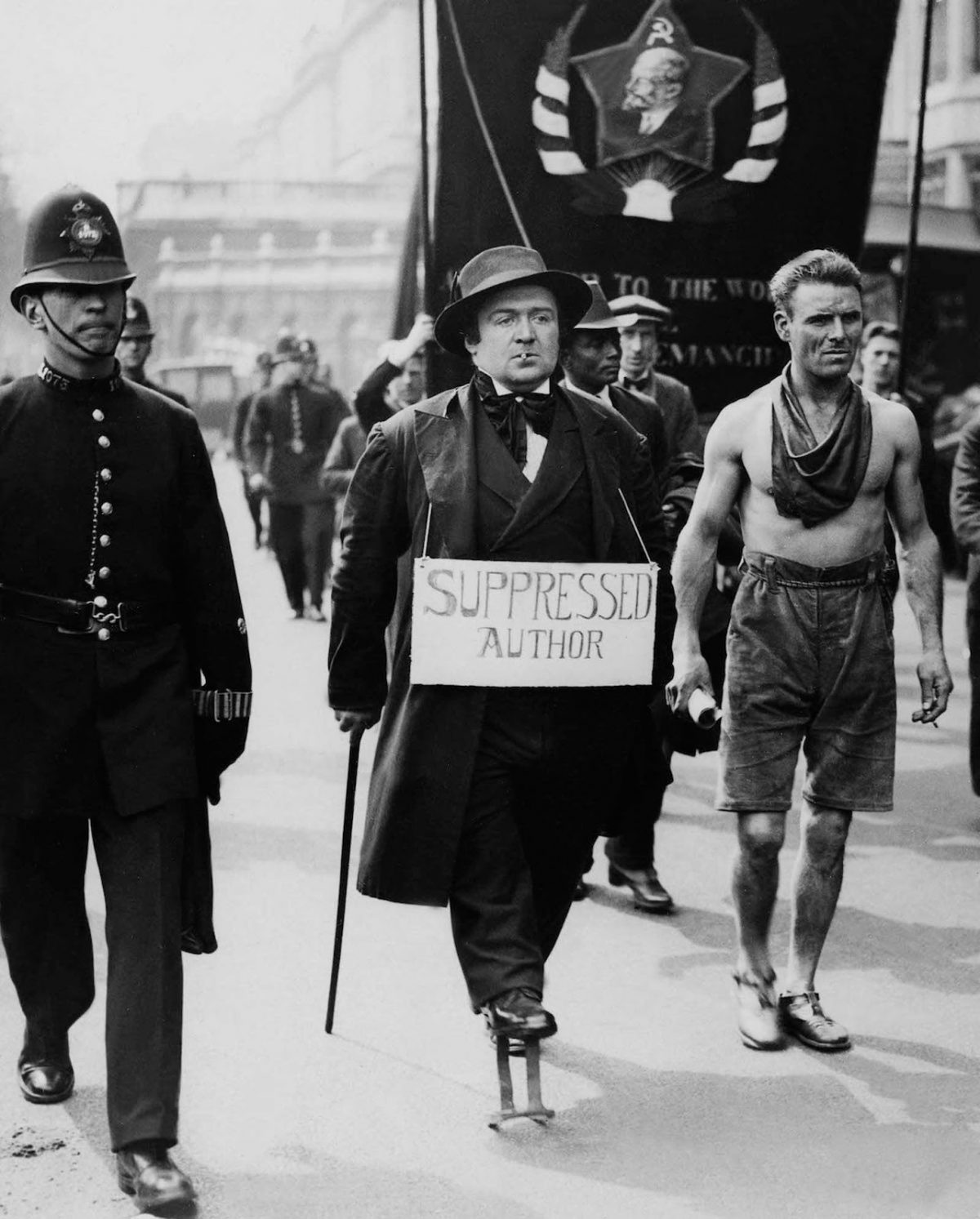
A Communist demonstration in England. 1928.
Insight into the Party’s thinking can be found in his polemicnby Robin Page Arnot, one of the CPGB’s founders. This appeared in The Communist, December 9, 1920.
Last week and the week before were full of surface excitements. British soldiers were ambushed in Ireland, well-known Irishmen were thrown into gaol, warehouses were fired in Liverpool, the Houses of Parliament were closed to the public, and barricades were put up in Downing Street. The newspapers are alternately depressed and excited. Ministers of the Crown are reported to be full of activity, and everything is done to frighten the good inhabitants of Kensington into a wholehearted support of the Government. But beneath all this there is a good reason for Cabinet Ministers to display the anxious activity with which they are credited by the newspapers. From behind the barricades they are peering out at something more dreadful than their Sinn Fein adversaries, something before which their political witchcraft and their armed forces are to no avail. They do not face it or understand what it is: they refer to it as “bad trade,” or “period of depression,” or “heavy unemployment figures.” They dare not realise what is actually upon them, even to themselves they dare not say: “Capitalist production is ceasing to produce.”
Pills for an Earthquake
Meantime, they are busied with hasty attempts to mitigate the crisis. Out-of-work benefit is being paid at the miserable rate of 15s. a week. Arterial roads are to be constructed. Schemes of relief are to be encouraged. But the Government is well aware that whatever they may do now will only have a surface effect. To go deeper they dare not; for the only remedy for this mortal sickness of society would mean the destruction of all they are trying to preserve.
Bourbons of Industry
The employers, for their part, speaking through their mouthpiece, the Federation of British Industries, have issued their pronouncement. For two years now they have been calling for “More production.” And now, by this winter, every worker knows that by “more production” is meant, not production for use, not for cheapening of goods, but such a greater output per man as will reduce the “labour cost” of every job and gain for the employer a greater profit or wider markets. The worker knows now that though the employer may call it “production” in his speeches, he writes it down as “profit” in his books. Yet the F.B.I., having learnt nothing, is still calling for “More Production.”
The End of Devil Worship
Faced by this, and remembering the calls that were made on him during the war; remembering, too, his relatives and his friends who were killed to make the world safe for democracy, the worker is beginning to awaken to the nature of capitalism. For too long he has been drugged. It is now with him as it was in the maritime empire of Carthage. We read that the Carthaginians used to feed their god Moloch with human sacrifices. But the victims were drugged before their bodies were thrust into the furnaces, so that the men and women who were passing their children through the fire to Moloch heard no cries that might disturb their besotted adoration of their god. But now the victims are undrugged; their shrieks are heard and the listening crowd of worshippers of capitalist efficiency and sufficiency are beginning to wonder. The masses of workers are beginning in their minds already to make an end of the cruel deity.
The Attack on the Workers
While the workers are thus awakening, the employing class and its Government behind all their concern for reconstruction, for mitigations, for “solutions of the problem of unemployment” are deeply roused to defend themselves. In Parliament we have Bills, and at banquets we have speeches; throughout the country we have the apparatus for doling out the fifteen shillings. All over Europe we have the same ostensible concern. In Germany, in France, in Italy, this crisis is found and for it these sticking-plasters are made. But beneath all this something impels the capitalists to work for their own ruin. Those that are doomed go mad before their end. And so the successful robbers of Versailles and the penitent thieves of the Wilhelmstrasse alike are prepared to use the crisis for a desperate attack on the working class.
The New “Economists“
In this country the cry is “economy.” Everything is to be “cut down.” What is everything? Is it to be the Navy, the armies of Mesopotamia and India, the garrison of Ireland, the luxuries of the rich, their mansions and motor cars, their fashionable and expensive doctors, their Public Schools and private tutors? No. No. What is to be “cut down” is the worker’s education, the worker’s housing, the hospitals for the workers. Of all these aids to his standard of life the worker is to be deprived; the working women and children are to work double shift in the factories, and “above all, wages are to be cut down. And should a Communist make a speech which might be dangerous to these “economists,” then that man too must be cut down.
It is the same as it was a hundred years ago, after Waterloo. Again we have a world shattered by war, markets impoverished abroad and misery and oppression at home. And every month the capitalists are proving themselves essentially the same as they were in the time of Sidmouth and Castlereagh. Only this time the working class are organised to protect themselves against capitalism, and, it may be, soon to overthrow it.
The Crisis of Capitalism
The situation is, therefore, this: The after war crisis of which unemployment is a part, is finding no solution in the measures of the Government. On the contrary, the crisis is awakening the workers to the nature of capitalism, and at the same time is rousing the capitalist forces to deliver an attack on the working class. The counter-attack of the workers is not the seizing of town halls and libraries by the men out-of-work. Not even if they go further and seize factories will it be the counter-attack. The real counter to the onslaught of the capitalist’s lies in the feeling of the workers that they have a moral right to do things that are “illegal” and “criminal.” The spirit of the workers is rising superior to the morality imposed on them by capitalism. The man lacking bread to give to his wife and children is a terrible figure which towers above the puny morality and legality of capitalism, and demands in a voice of thunder the reason for capitalism’s existence. To that annihilating question capitalism has no reply. It has sunk into moral disrepute. It is rejected and despised, and its end is near. Capitalist production is ceasing to produce.
———————————
What is the immediate task for the worker? The measure of defence afforded him by his trade unions will not last for many months. The trade union funds accumulated during the full employment period of the war will be drained away more rapidly than in 1908-9, when the cost of administration was a bagatelle compared to what it is now. In many industries at present the capitalists would welcome the prospect of a strike, and the current demands for reduction in wages are not trade by them in any forgetfulness of this fact. If then at the end of some months the worker finds himself with his back to the wall, what is he to do? There is nothing but to fight in an ever sterner mood; to recast organisation of his trade unions into a more effective formation; to base the unit of organisation on the unit of production, and, snatching courage from despair, to join together with his fellow workers in industrial unions. The mood of despair does not last. It passes from despair into desperation, and when that point is reached nothing can hold from massing together for the overthrow of a civilisation that is decayed and rotting
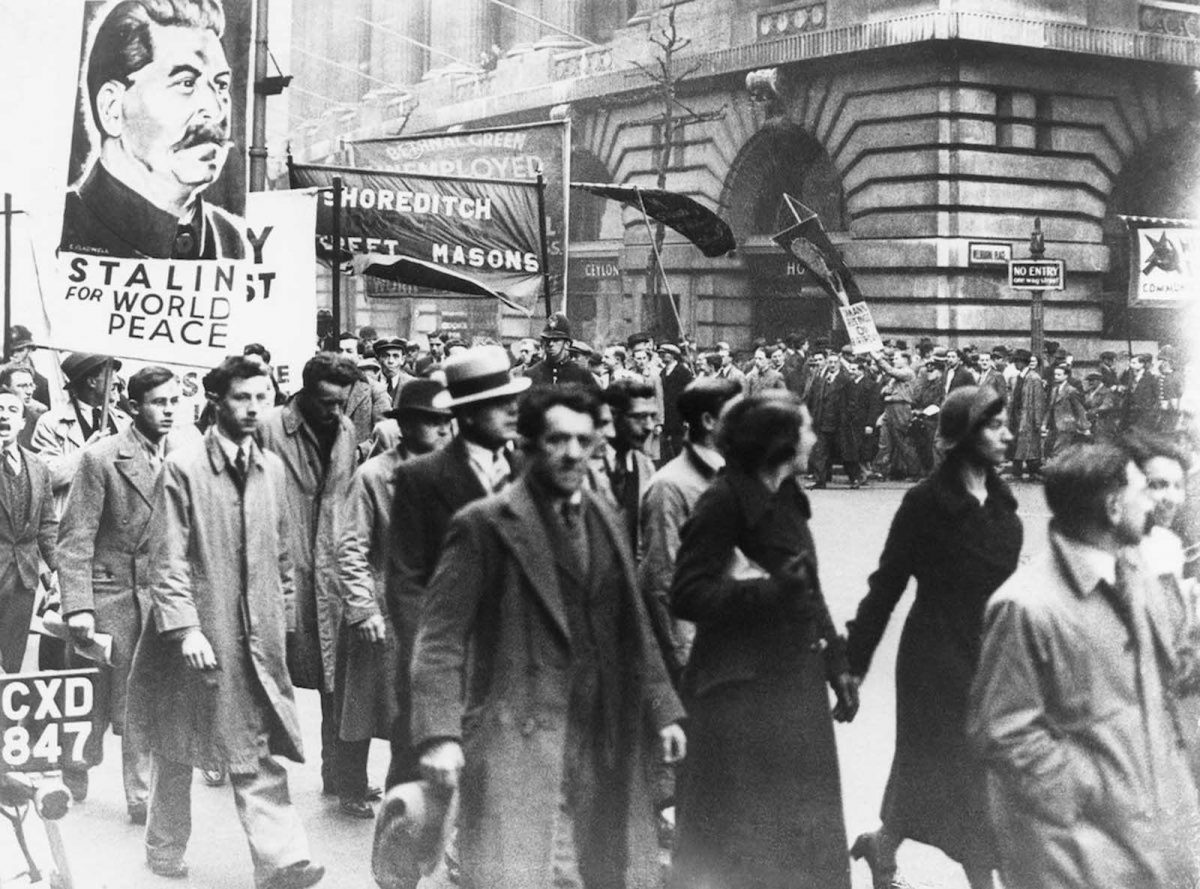
English Communists marching in London. 1936.
Ever since 1956, the CPGB “had been receiving money from the Soviet Union – wads and wads of banknotes, handed over in clandestine meetings between an embassy official and gneral secretary John Gollan’s deputy Reuben Falber. In the early days, it had been about £100,000 a year, but by the late 1970s was down to about £14,000… it carried on for four more years until 1979.”
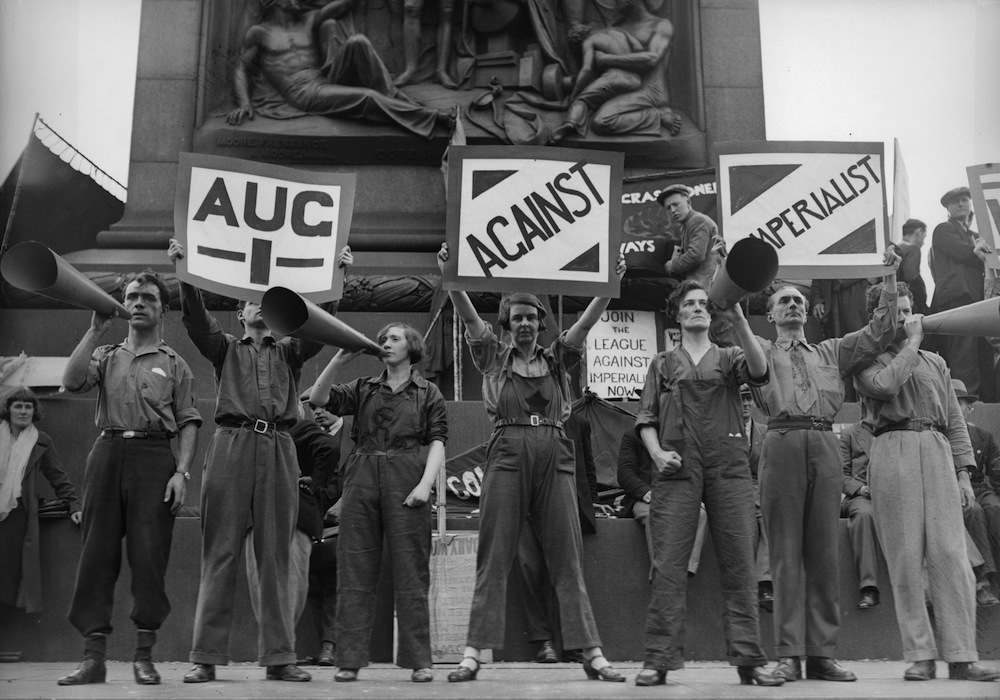
1st August 1931: The League Against Imperialism canvass for support at Trafalgar Square in London. (Photo by Fox Photos/Getty Images)
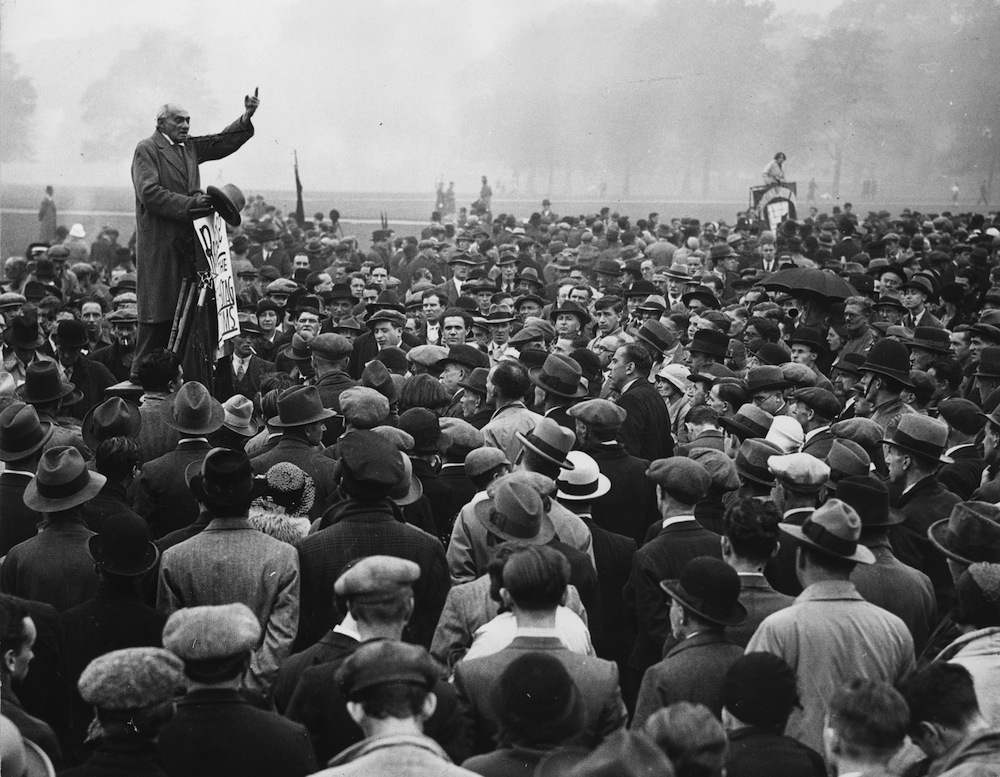
24th September 1933: Addressing crowds at Speakers’ Corner in Hyde Park, Communist MP Saklatvala Shapurji calls for the release of the Reichstag Fire suspects in Germany. The fire, which burned down the Reichstag parliament building, was allegedly started by Communist Party member Marinus van der Lubbe and gave the German government a pretext to introduce a state of emergency across the country and suppress opponents of the Nazi regime. (Photo by Keystone/Getty Images)
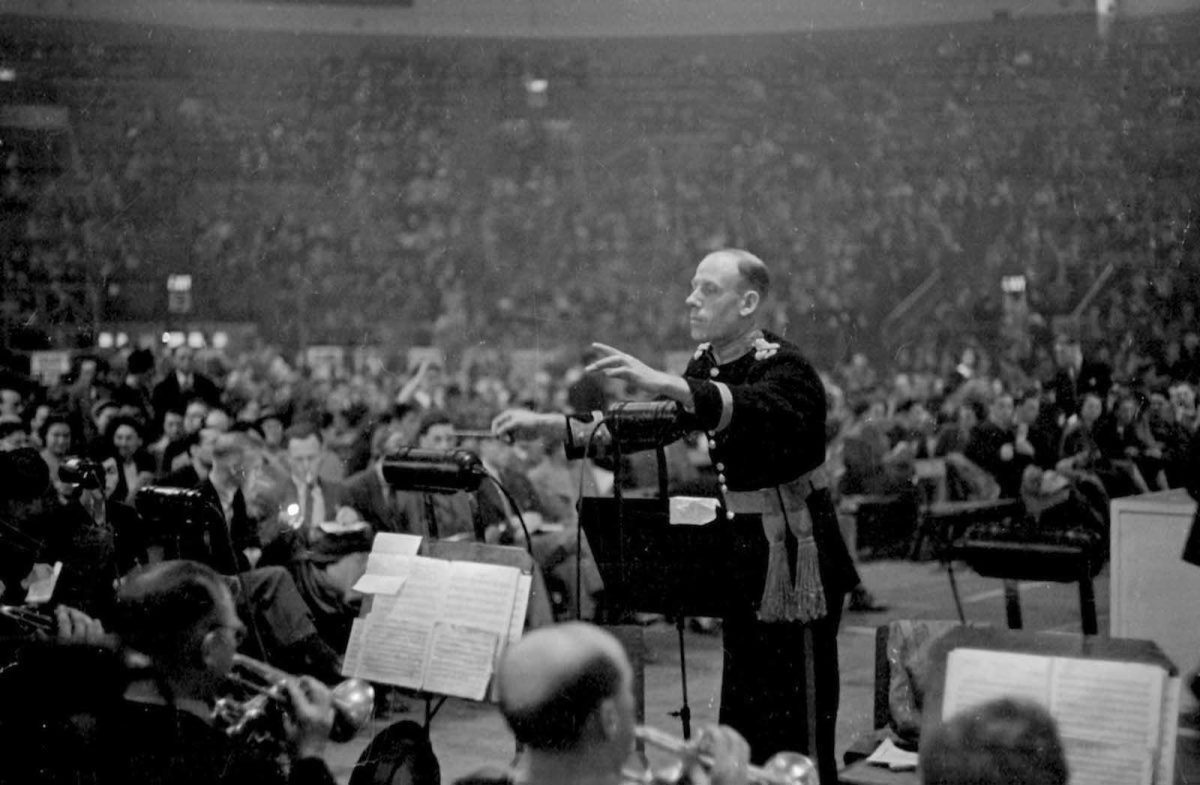
A band leader conducts his band at a meeting of the British Communist Party at the Empress stadium in Earls Court, London. 1939.
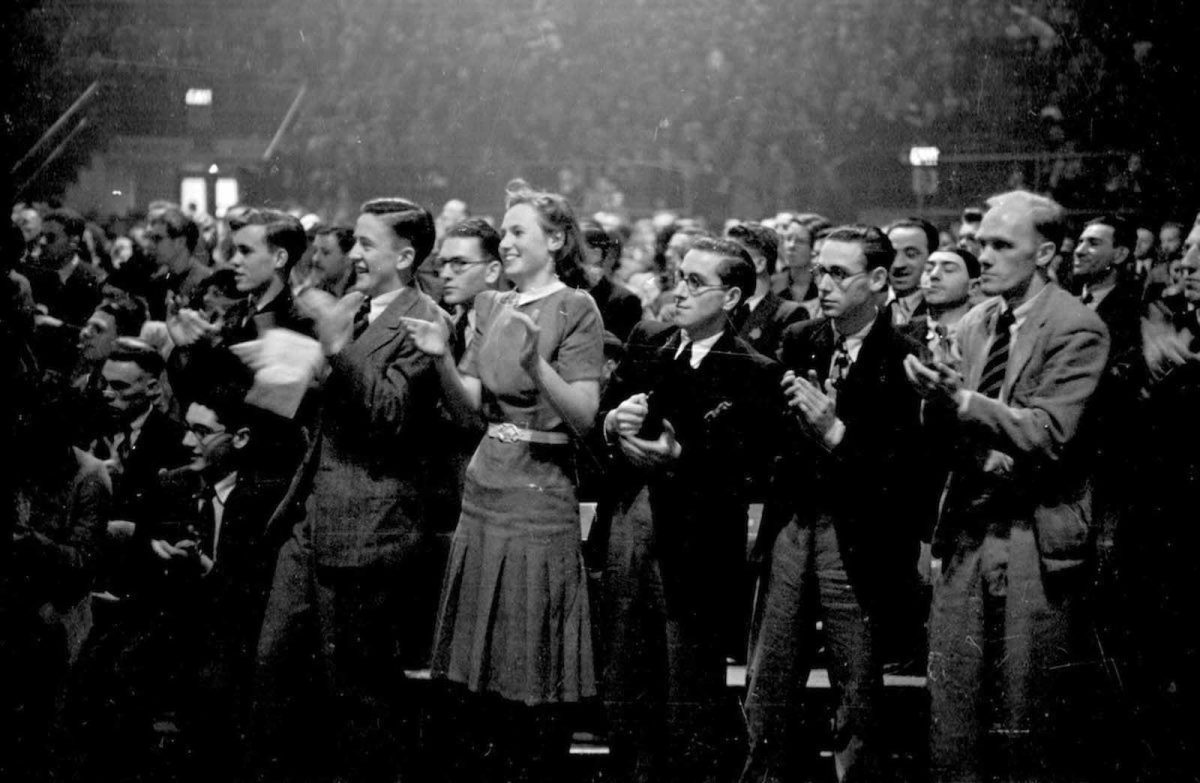
A crowd of over eight thousand people attending a meeting of the British Communist Party at the Empress stadium in Earls Court, London. 1939.
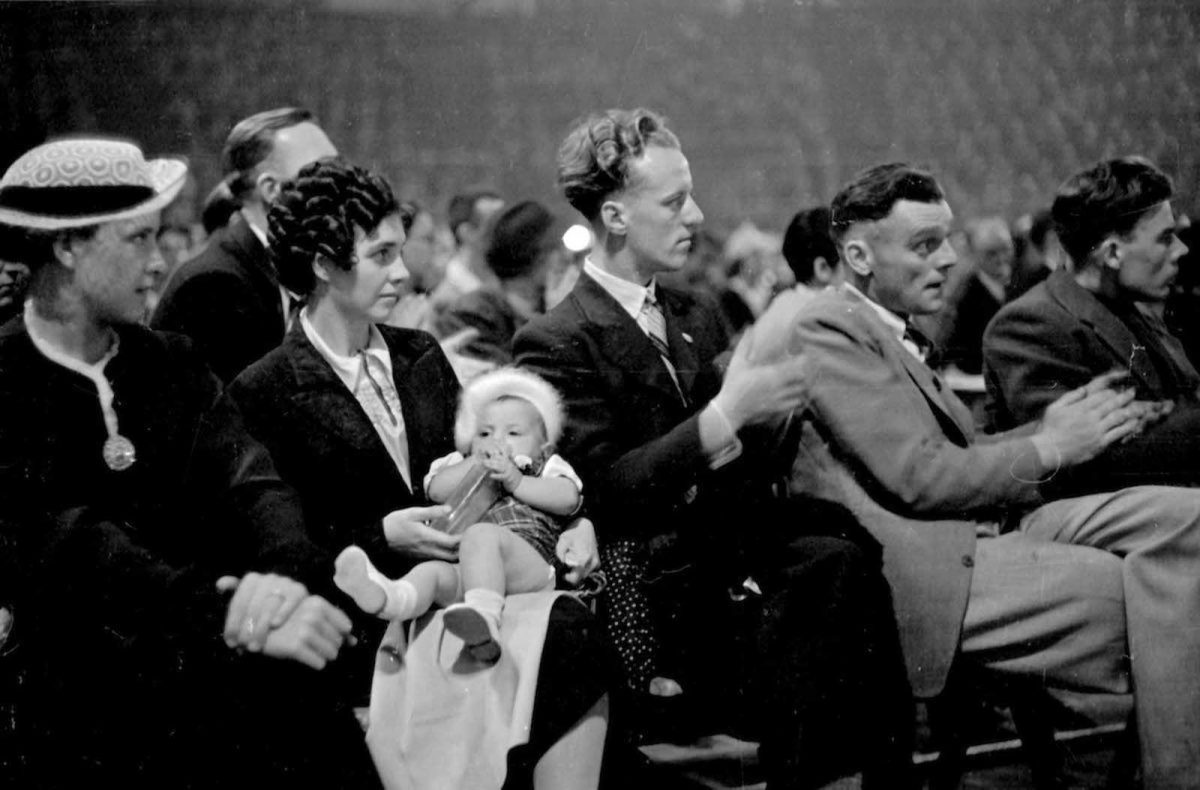
Section of the crowd attending a meeting of the British Communist Party at the Empress stadium in Earls Court, London. 1939.
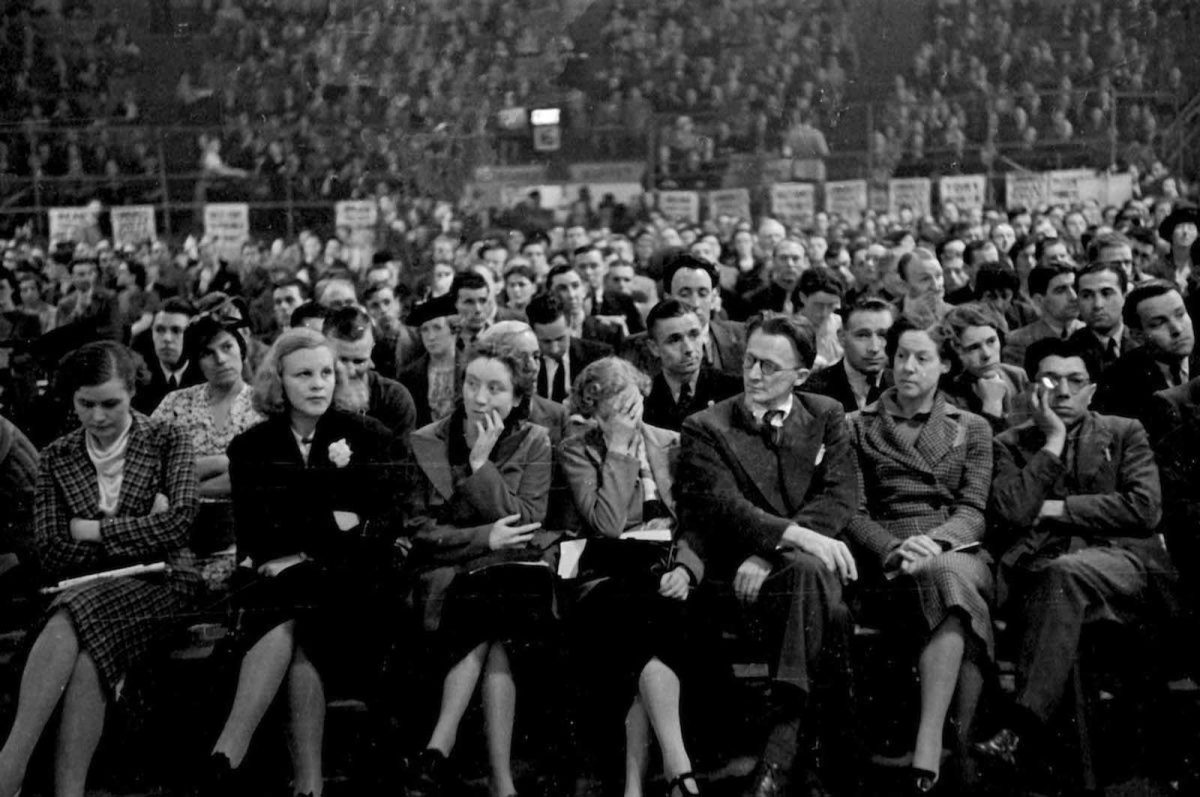
Members of the crowd at a meeting of the British Communist Party at the Empress stadium in Earls Court, London. 1939.
The British security services spied on the communists. The National Archives are a rich source of information on how British communists was watched and their movements recorded. These are two file entires:
Solomon Frankel:
Frankel, who died in May 2007, was a prominent London Communist Party member, a veteran of the Battle of Cable Street and the International Brigade, and of the less well-known Communist Party-inspired demonstrations at the Savoy Hotel in 1940.
Despite this, it was not until 1941 that a Security Service file was opened on him (largely because of suspicions surrounding his sister Jenny, also a member of the Communist Party, who was working as a fitter for Handley Page). By then, Frankel was working as a shelter marshal (and later as an air-raid warden) in Stepney.
This file, which covers 1941-1957, throws much light on the activities of the Party in London clothing manufacturers. Frankel acted as branch secretary at several of these after the war. It also presents an interesting view of the lives of a London Jewish Communist family during this period, as the file covers not just Solomon but also the activities of his siblings.
Arthur Horner
Horner (1894-1968) was a founder member of the Communist Party in Britain in the 1920s, and served the party in many senior positions. He was also an active trade unionist, and was General Secretary of the National Union of Mineworkers, 1946-1959. These reconstituted files reveal some of the tensions Horner felt between his roles in the Party and the Union. A biography of Horner is currently being written by Dr Nina Fishman of the University of Westminster.
Horner was first placed under Security Service surveillance in 1921 when he appeared on a list of suspected British communists. KV 2/1525 covers this initial supervision up to 1935. The file contains copies of Home Office warrants to monitor his correspondence at addresses in Mardy and later Llanelli, South Wales, and the summary product of that surveillance. Horner stood as the Communist candidate at the elections for Rhondda East in 1931 and again in 1933, and was arrested in December 1931 for riotous assembly at Mardy during a union protest. The watch on Horner’s contacts continued while he was in Cardiff prison, and the Security Service investigated some of those who campaigned against his imprisonment (which resulted in the Home Secretary granting 3 months of remission to his 15 month sentence). The file includes a copy of Horner’s 1933 election pamphlet, and a photograph of Horner.
The first indications of tension between Horner in his role as president of the South Wales Miners’ Federation and the Communist Party appear in KV 2/1526 (1935-1947), which contains a Metropolitan Police report of October 1938 stating that “The former [the Communist Party] fear that they are losing their grip on Horner.” The file includes further product of the surveillance on his phone and written communications, reports of mineworkers’ meetings, and includes a history summary sheet with photographs of Horner. It covers the period of his election as General Secretary of the National Union of Mineworkers (August 1946). The file includes a copy of his pamphlet “The Communist Party and the Coal Crisis” of 1945.
The close watch of Horner continues in KV 2/1527 (1947-1950), which includes the suggestion, made by Krivitsky, that Horner acted as a recruiting agent for the Communists – there was no previous hint of this activity on the file.
In KV 2/1528 (1950-1952) the reports of tensions between Horner and the Communists increase (a Metropolitan Police report for instance refers to Horner’s “disgrace” in the Party), and KV 2/1529 (1953-1934) encompasses the period where his dilemma led Horner to heavy drinking as he considered a possible defection from the Party. One report from an unnamed source (folio 304) describes how “…far from thinking it over, he is just drinking it over.”

11th October 1936: A heavy police presence at a Communist rally in Victoria Park, London. One young communist raises his hand in a clenched fist salute. (Photo by Fox Photos/Getty Images)
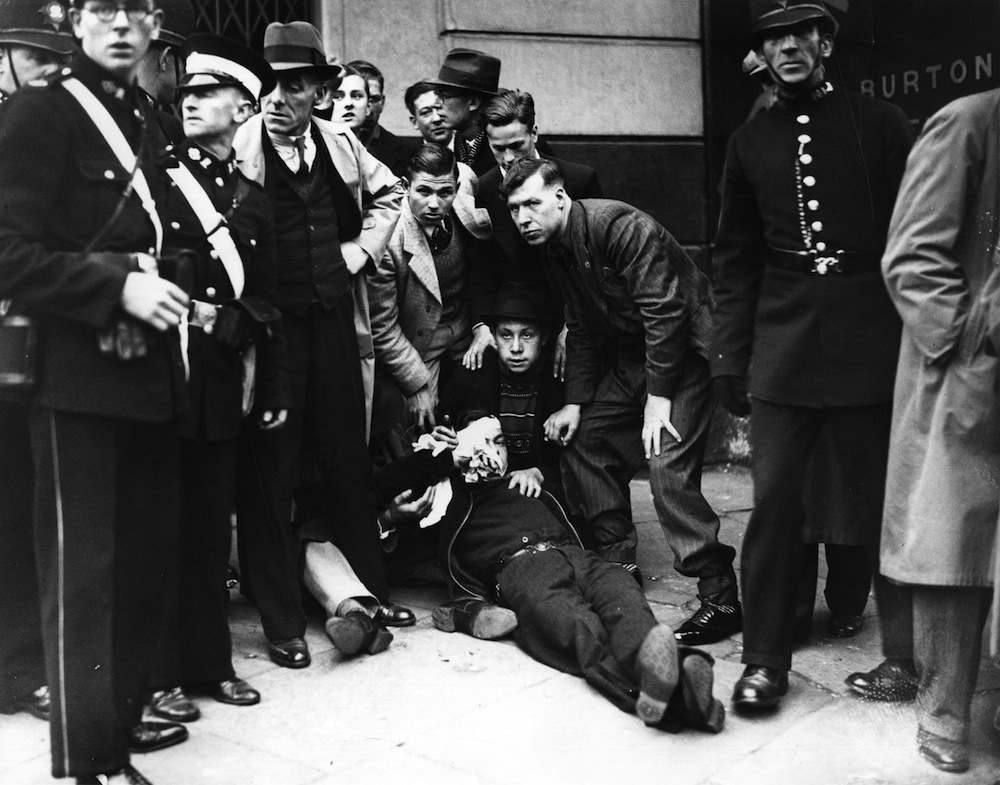
11th October 1936: Attending to an injured man following the riots in Victoria Park, London, where the Communists converged after their march through the East End. (Photo by Fox Photos/Getty Images)
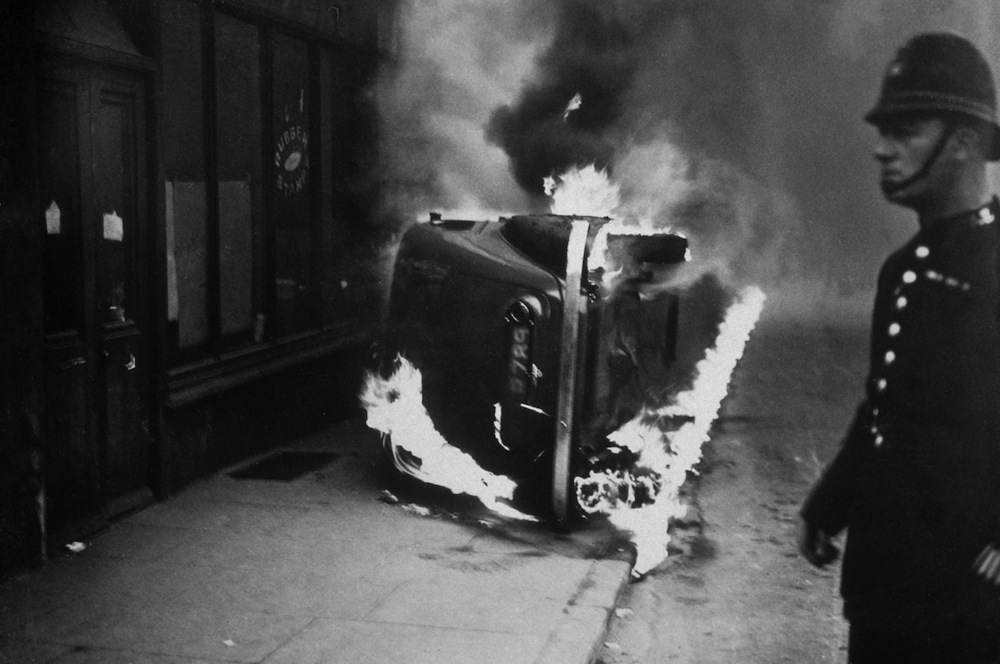
circa 1936: A policeman stands by a burning car, set alight during a communist march in the East End of London. (Photo by Topical Press Agency/Getty Images)
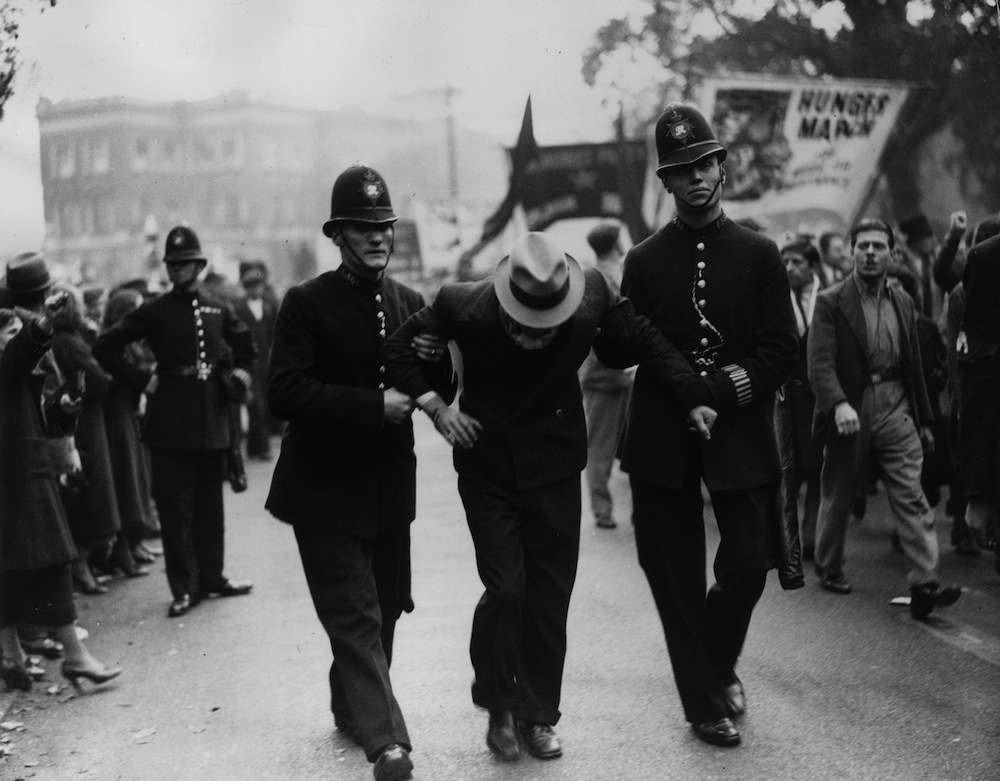
11th October 1936: Two policemen making an arrest during a rally at Clapton Square, Hackney, London. A group of Fascists held a mass meeting at one end of the street, and a group of Communists at the other, resulting in inevitable clashes. (Photo by Fox Photos/Getty Images)

Supporters of Communist candidate J. R. Campbell marching through Woodford in Essex in 1951
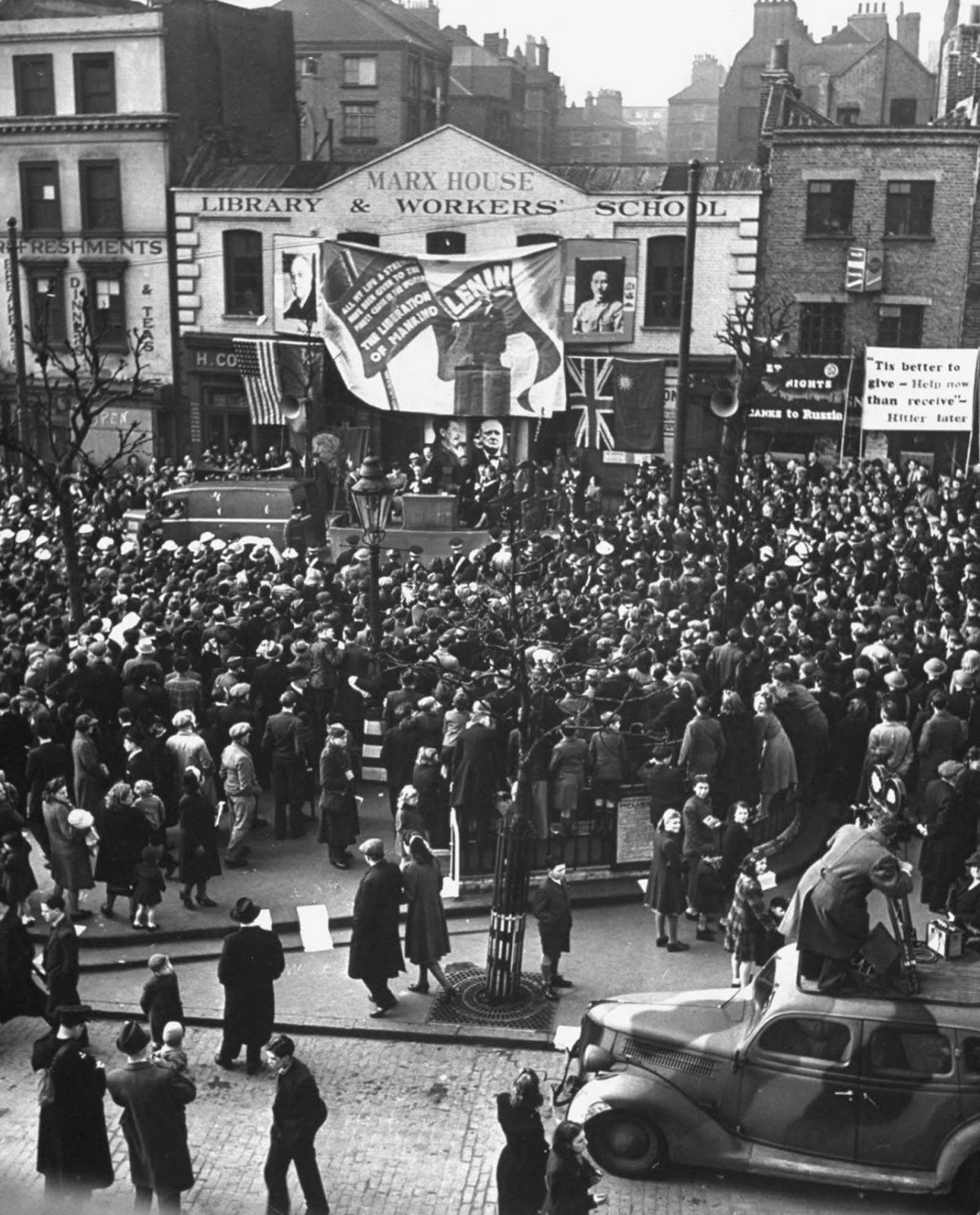
Mass demonstration at Clerkenwell Green in front of Karl Marx’s house, now the headquarters of the Communist Party in London. 1942.
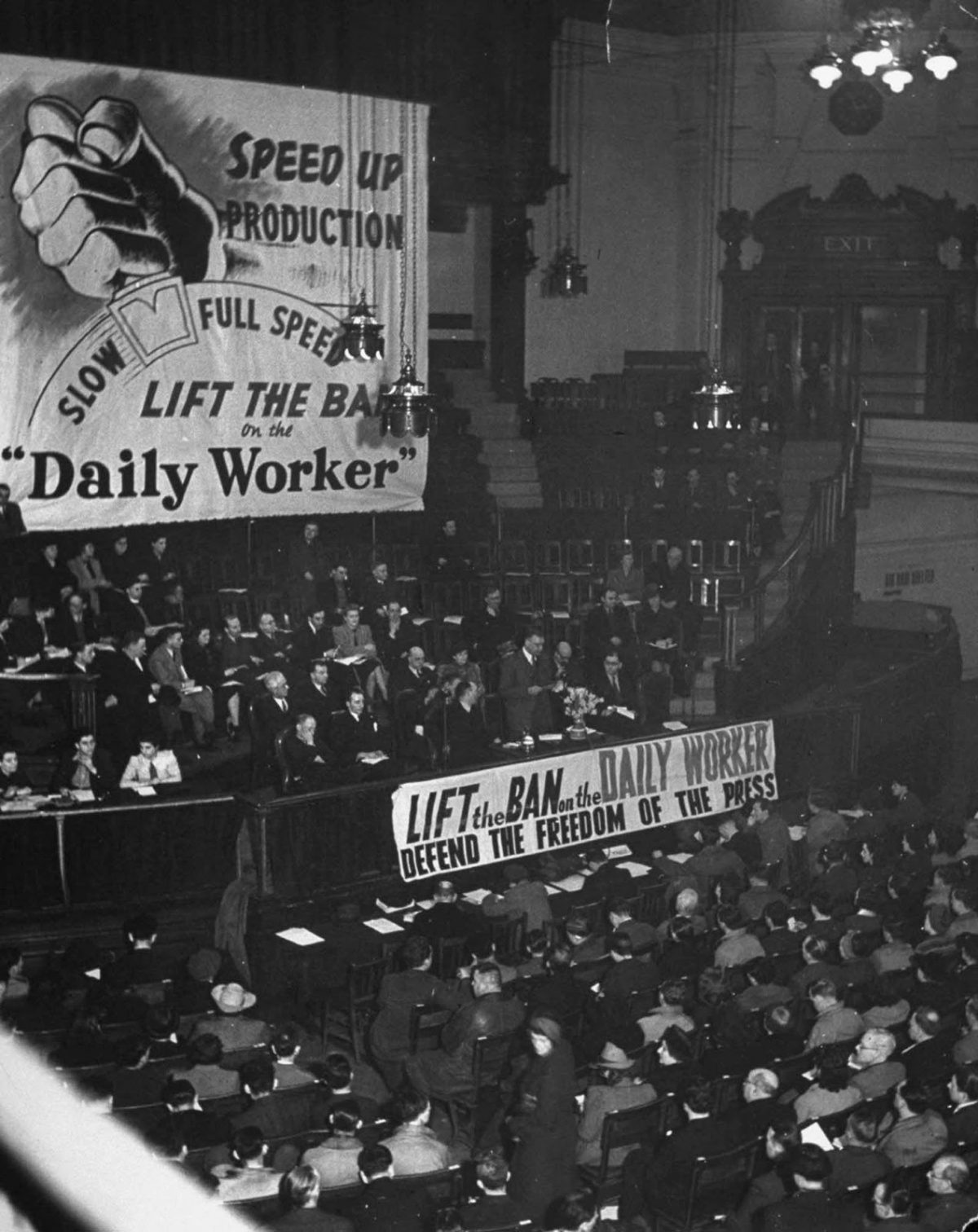
Meeting in the Westminster Central Hall, London, organized by the Communist Party to gain support for the campaign to lift the ban on the Daily Worker newspaper. 1942.
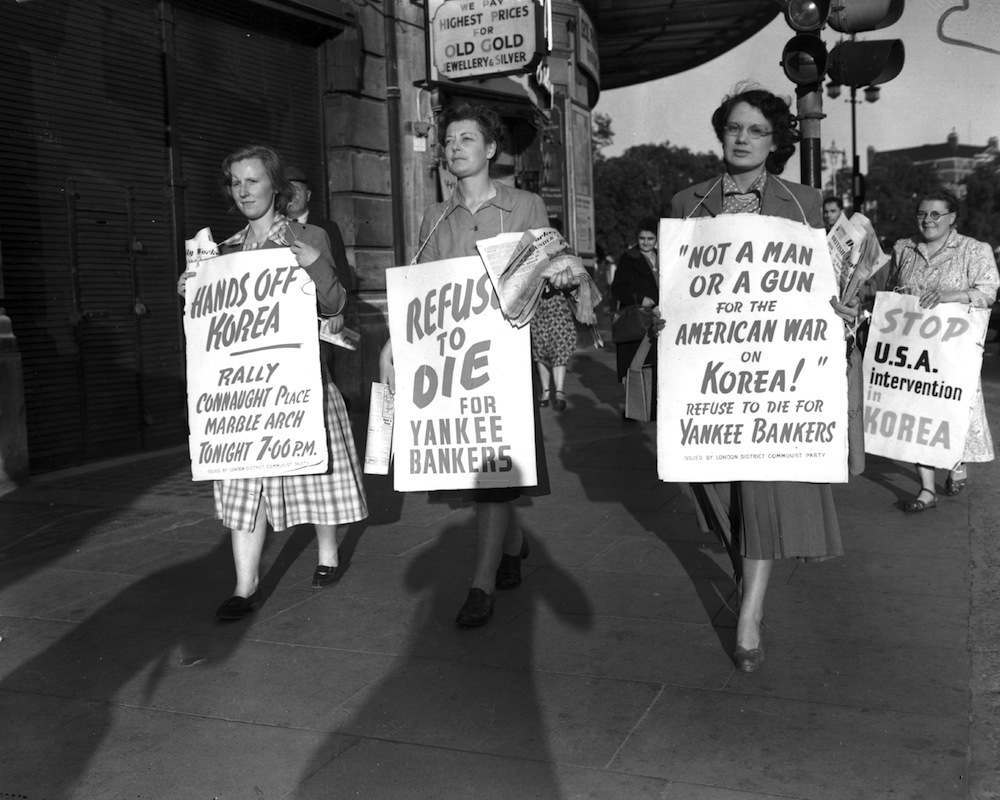
1950: Women with placards demonstrating against the Korean War, as part of the Communist Peace Demonstration held at Marble Arch London. (Photo by Keystone/Getty Images)
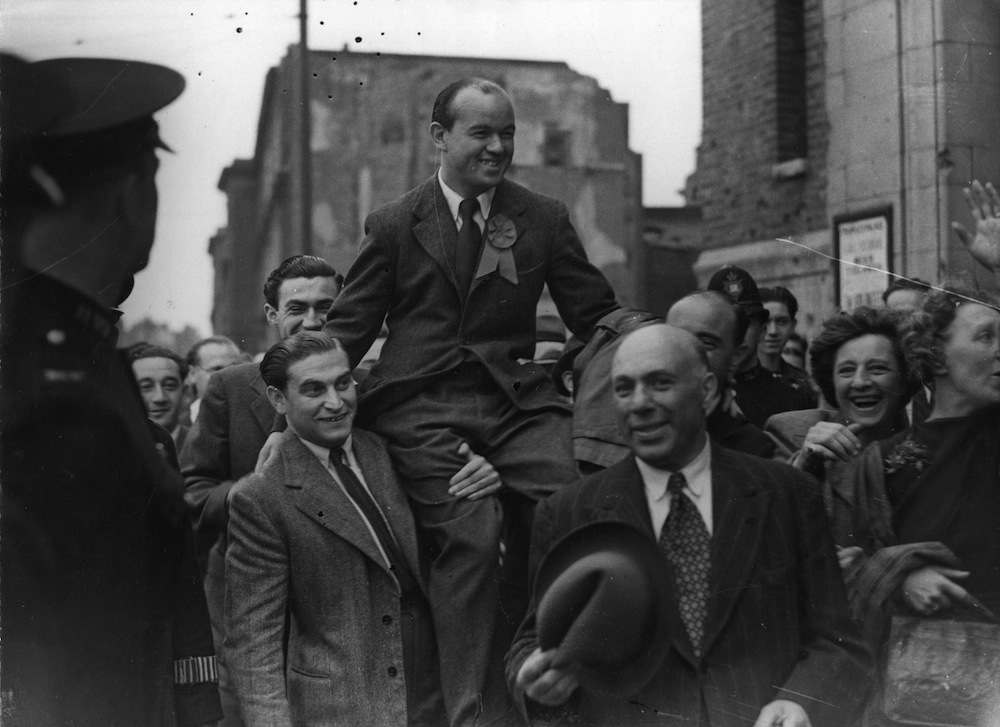
26th July 1945: Communist MP Phil Piratin (1907 – ) is chaired by supporters after winning an election in Mile End, London. (Photo by Keystone/Getty Images)
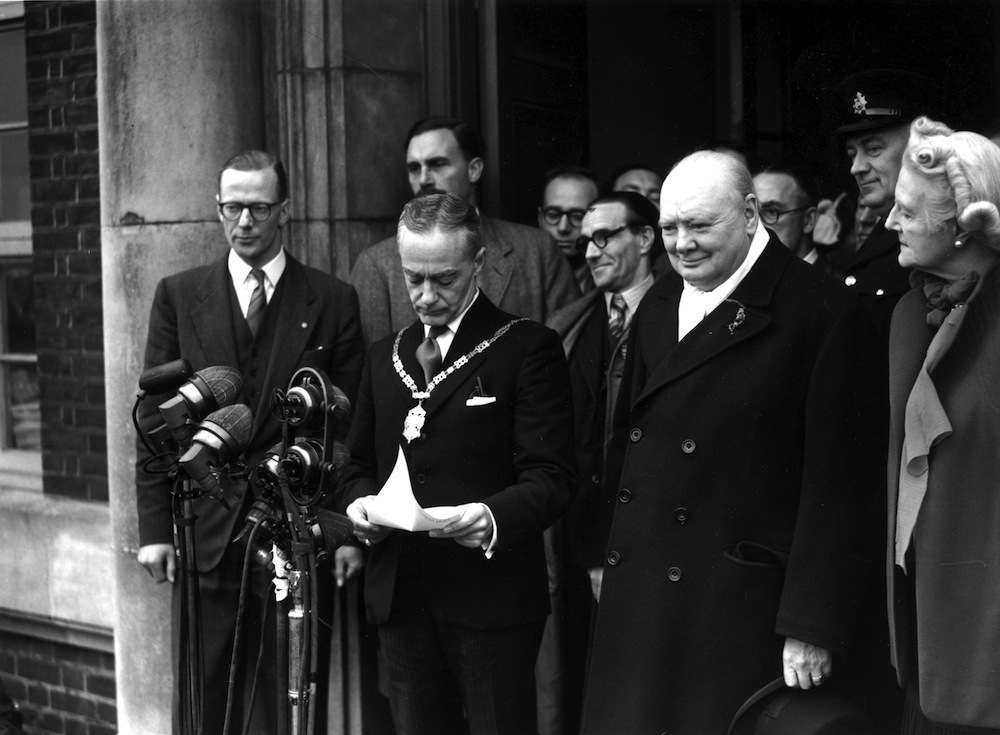
26th October 1951: British statesman Winston Churchill (second from right) and his wife Clementine at St Barnabus Secondary School at Woodford Green in Essex while the results are being read out during the General Election. Mr Campbell, the Communist Party candidate, is to the left of Churchill. (Photo by J. A. Hampton/Topical Press Agency/Getty Images)
In 1955, the party published “Forging the Weapon – A Handbook for Members of the Communist Party”:
There is no higher honour than membership of the Communist Party.
The noble aim of our Party is to establish Socialism and abolish the right of one man to rob another of the fruits of his labour. This is what makes our Party different from all others.
Nowhere in the world has Socialism been established except where the working class has been led by the Communist Party. The winning of working-class power and the advance to Socialism is impossible under the old Social Democratic Parties.
Only where the policy of the Communist Party has led to the people taking the affairs of their country into their own hands is the future assured. There the bankers, landlords and profiteers no longer exist. Social ownership prevails. As a result, freed from all capitalist restrictions, there is rapid and continuous economic development. Economic slump is impossible. Living standards steadily forge ahead. Science and culture advance. New opportunities open out for all men and women, and especially for young people. Such a social system alone is the guarantee that atomic science and automation can really flourish, serving the people, not the profiteer. It is no accident that it is precisely the Socialist countries which make the fight for peace their main and enduring aim on the international field. For Socialism means peace and needs peace.
This is the Party you belong to. We should be proud of the men and women who formed it thirty-five years ago. They recognised that to establish Socialism in Britain the working class needed a Marxist party. The Labour Party was not such a party…
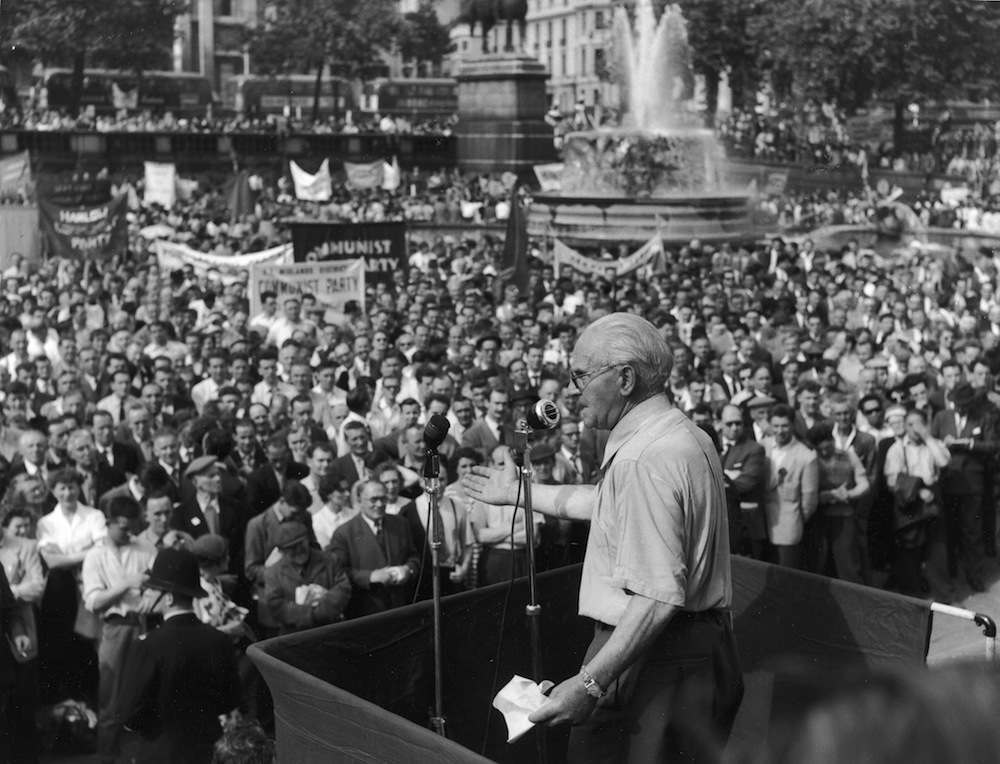
Scottish politician Willie Gallacher (1881 – 1965), a former Scottish member of Parliament, speaks to the crowds during a Communist Party rally in Trafalgar Square, London, England, June 30, 1958. (Photo by Express Newspapers/Getty Images)
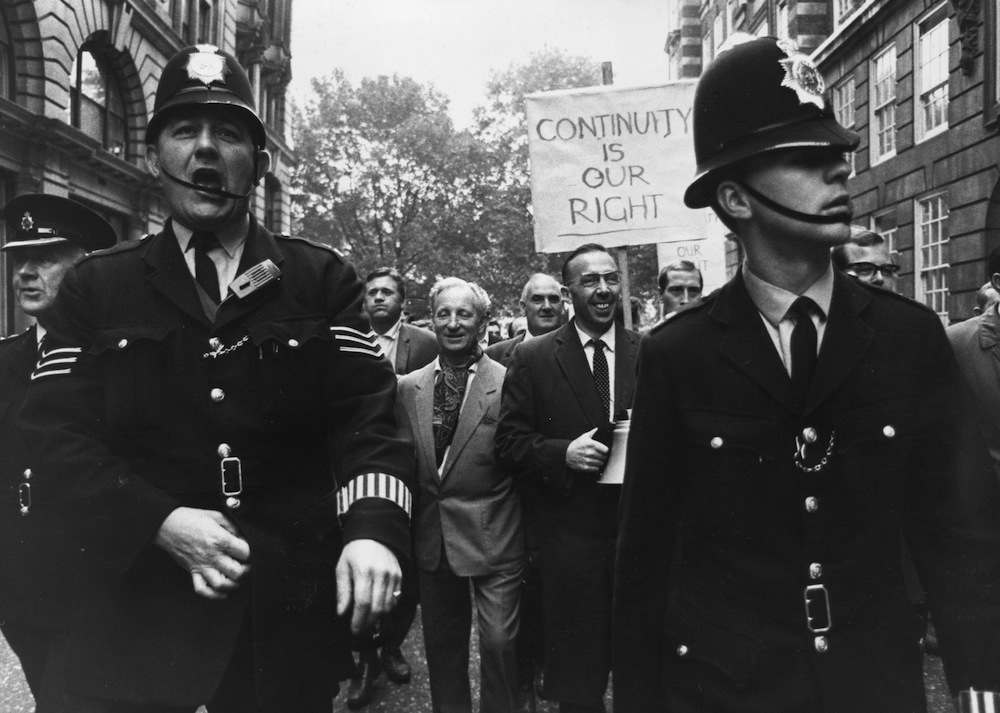
10th October 1967: Unofficial dock leader, Communist Jack Dash framed between two policemen who were guarding the march of striking dockers on their way to Transport House in London. (Photo by Jim Gray/Keystone/Getty Images)
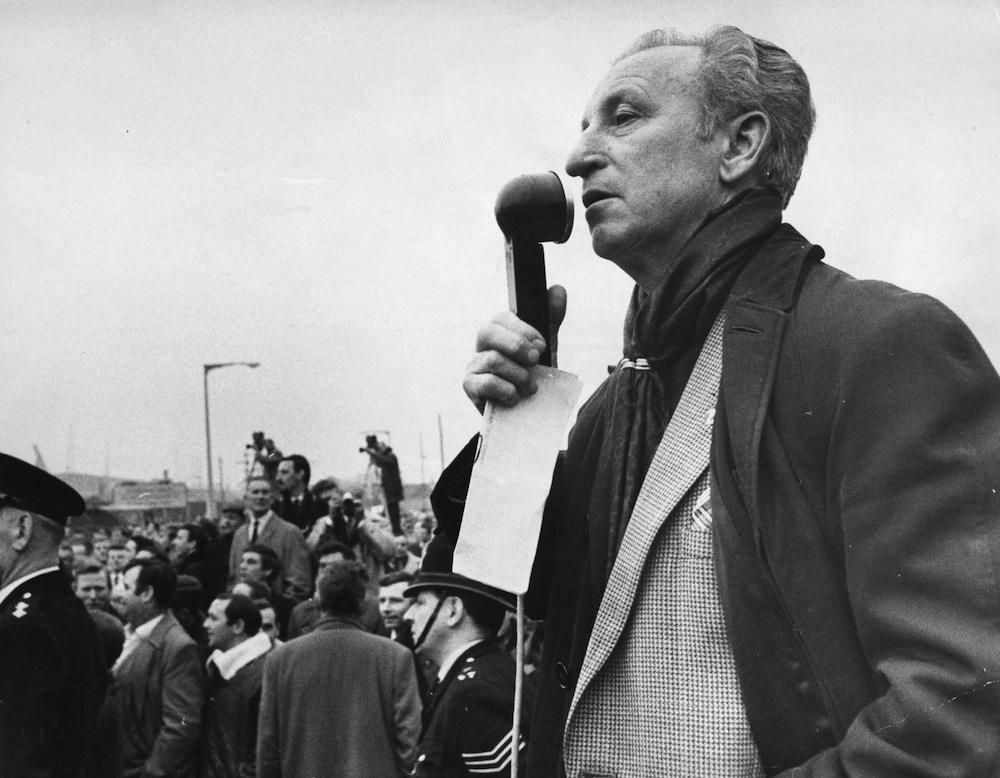
23rd November 1967: Jack Dash, Communist and unofficial dockers’ leader, addressing a crowd during a strike. (Photo by Sydney O’Meara/Evening Standard/Getty Images)
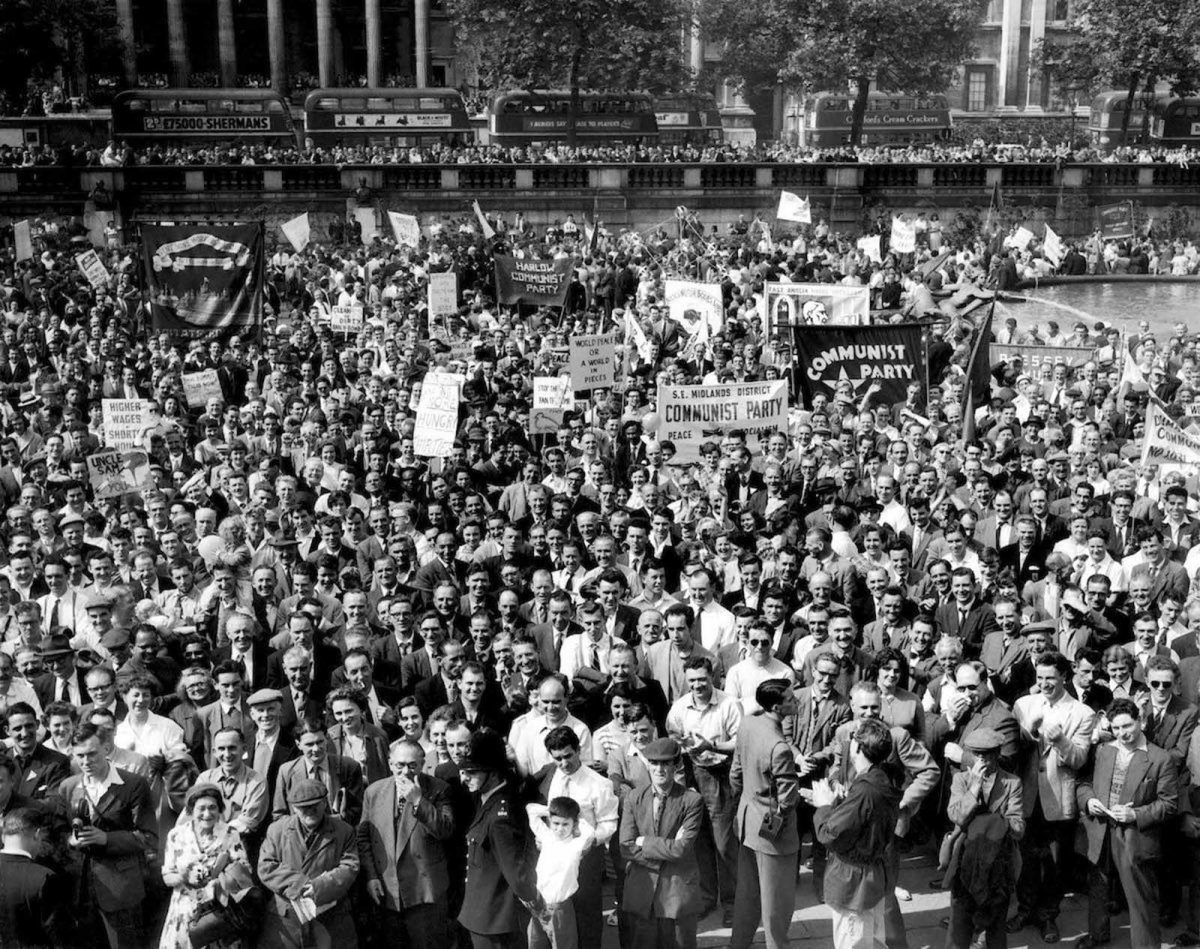
Communist party rally, Trafalgar Square, London. 1958
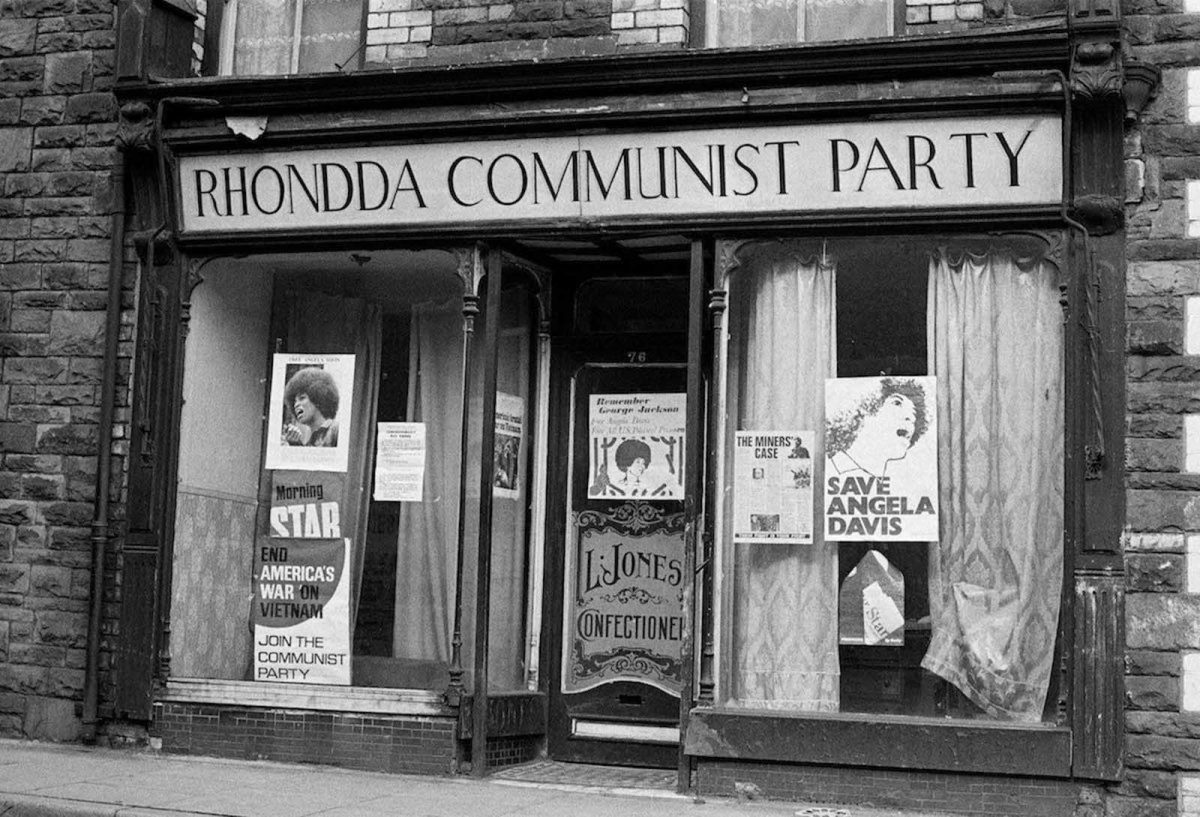
The headquarters of the Rhondda Communist Party in Wales. In the windows are posters of American political activist Angela Davis. 1972.
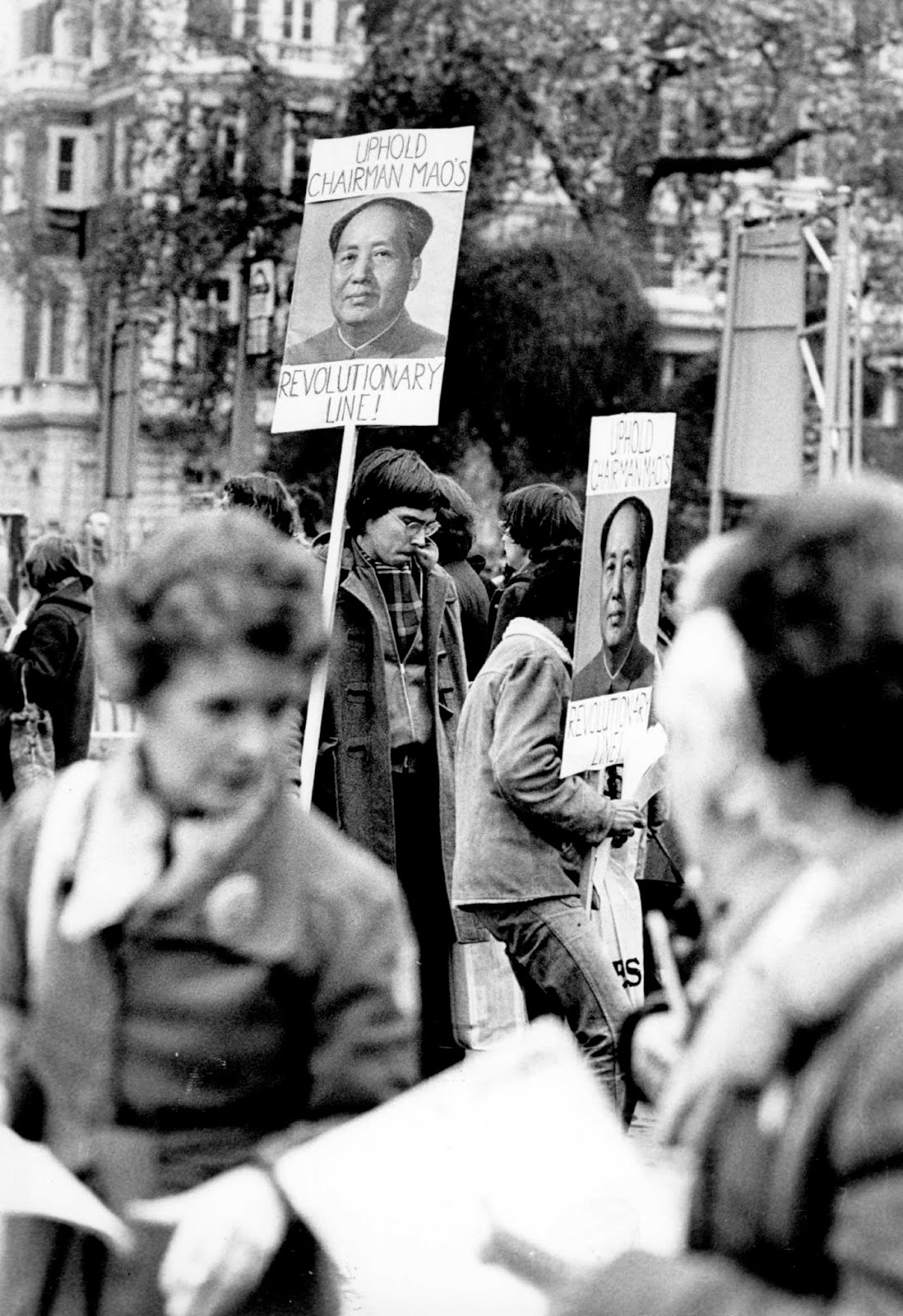
Demonstrators holding posters with pictures of Chairman Mao Tse Tung and the slogan ‘Uphold Chairman Mao’s Revolutionary Line’. 1976
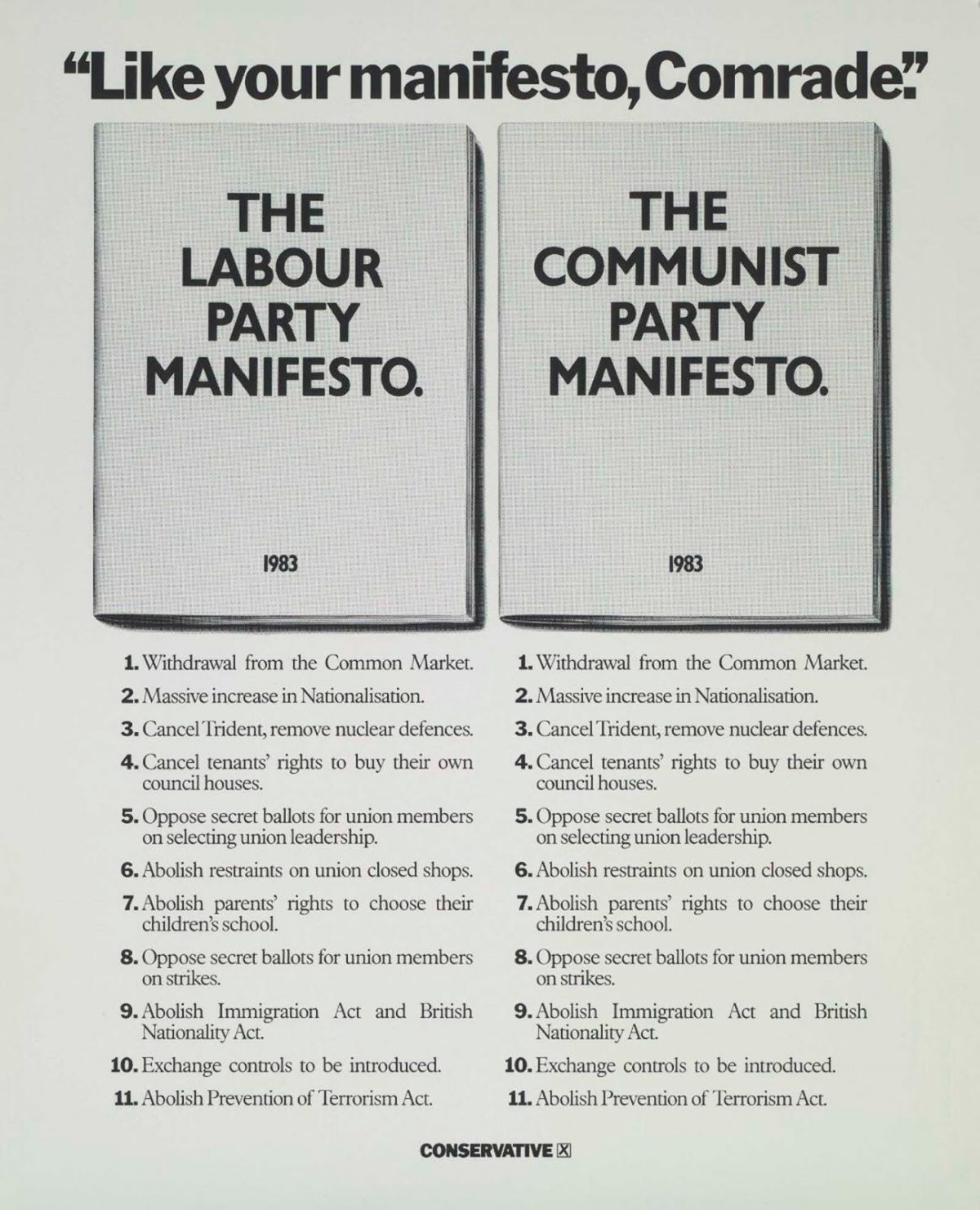
A poster for the British Conservative Party from the 1983 General Election. It compares the Labour Party Manifesto to the Communist Party Manifesto, with the caption ‘Like your manifesto, Comrade’. 1983.
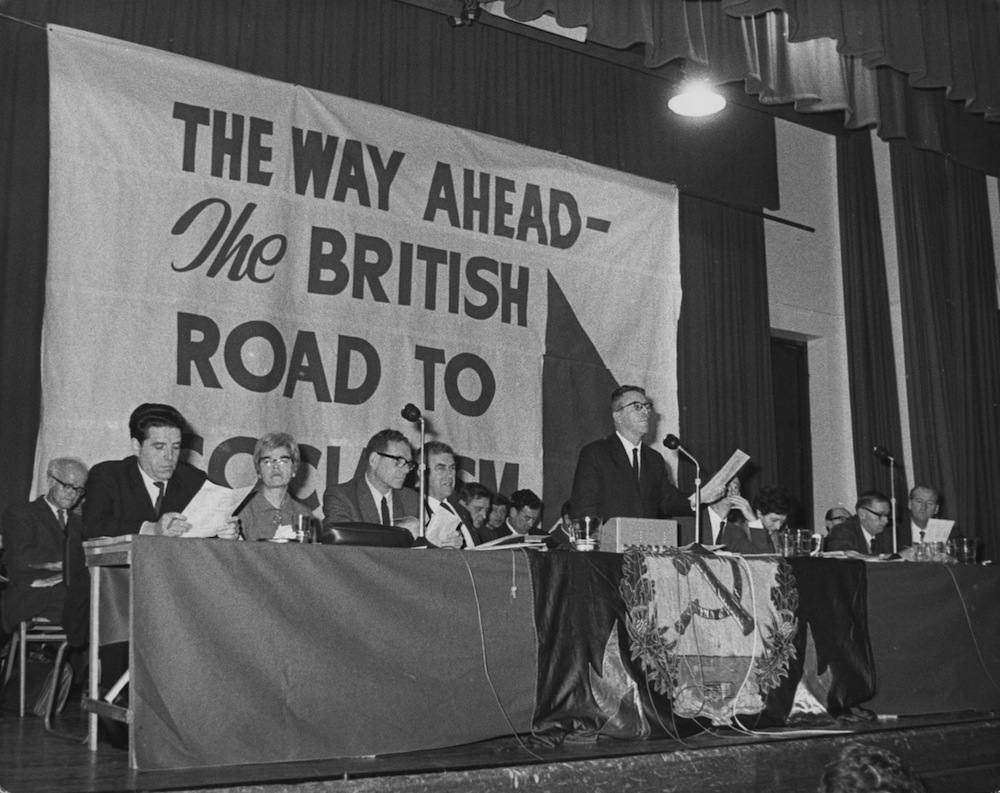
Chairman of the Congress Frank Stanley addresses the 30th National Congress of the Communist Party of Great Britain at Camden Town Hall, London, 25th November 1967. (Photo by Douglas Miller/Keystone/Hulton Archive/Getty Images)
If you were member of the CPGB, please let us know more. And if you have any photographs to share, please do.
Would you like to support Flashbak?
Please consider making a donation to our site. We don't want to rely on ads to bring you the best of visual culture. You can also support us by signing up to our Mailing List. And you can also follow us on Facebook, Instagram and Twitter. For great art and culture delivered to your door, visit our shop.

